- Reviews / Why join our community?
- For companies
- Frequently asked questions


Apple’s Product Development Process – Inside the World’s Greatest Design Organization
Apple’s Product Development Process may be one of the most successful design processes ever implemented. With a valuation that exceeds $2 trillion, there’s a lot that designers can learn from Apple and introduce into their own design environments.
Apple is a notoriously secretive business. In Steve Jobs’ time at the company it would have been near impossible to find out about the internal workings of the business. This isn’t surprising when a business’s market advantage is its design approach. It’s worth keeping it under wraps.
However, Adam Lashinsky, the author of Inside Apple: How America’s most Admired and Secretive Company Really Works has been given a look at the process. While there are still aspects of the way that Apple works that are shrouded in secrecy , you can get a good idea of the overall high level process through this book. And in this article, we’ve distilled the key takeaways from the book.
Apple’s Product Development Process
Design is at the forefront.

Author/Copyright holder: GiuliaPiccoliTrapletti . Copyright terms and licence: CC BY-SA 4.0
How do you give designers the freedom to design and ensure that the products they produce fulfil their visions? Well at Apple they put design at the forefront.
Jony Ive, the British designer who was the Chief Design Officer (CDO) at Apple, and his design team do not report to finance, manufacturing, etc. They are given free rein to set their own budgets and are given the ability to ignore manufacturing practicalities.
At the heart of the design department is the Industrial Design Studio where only a select few Apple employees have access.
It’s a simple concept that allows for the creation of incredible products.
Design Teams are Separated From the Larger Company
When a design team works on a new product they are then cut off from the rest of the Apple business. They may even implement physical controls to prevent the team from interacting with other Apple employees during the day.
The team is also removed from the traditional Apple hierarchy at this point. They create their own reporting structures and report directly to the executive team. This leaves them free to focus on design rather than day-to-day minutiae.
A Documented Development Process
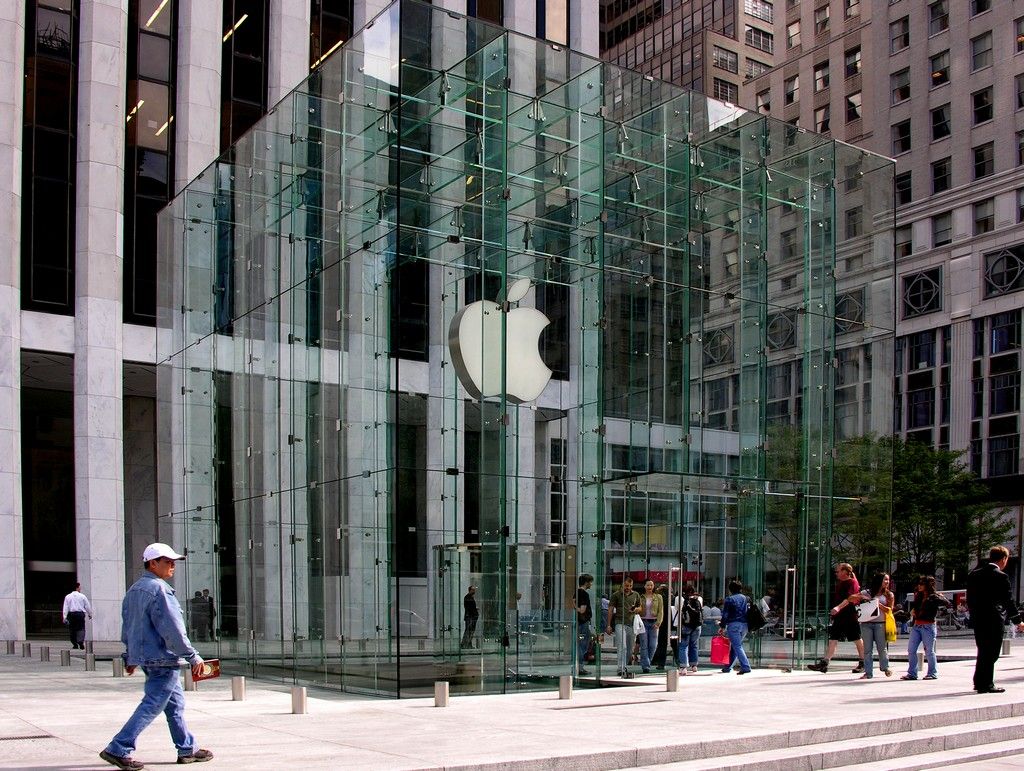
Author/Copyright holder: Ed Uthman . Copyright terms and licence: CC BY-SA 2.5
The Apple New Product Process (ANPP) information is given to a product development team when they begin work. It details every stage of the design process and it goes into elaborate detail. The idea is to define what stages the product creation team will go through, who will be responsible for delivering the final product, who works on which stage and where they work and also when the product is expected to be completed.
Monday is Review Day
The Apple Executive Team holds a regular Monday meeting to examine every single product that the company has in design phase at that point in time. This isn’t as daunting as it may sound; one of the keys to Apple’s success is that they don’t work on hundreds of new products at once. Instead, resources are concentrated on a handful of projects that are expected to bear fruit rather than being diluted over many lesser projects.
If a product cannot be reviewed at one meeting – it’s automatically at the top of the agenda for the next meeting. In practice, this should mean that every single Apple product is inspected by the executive team at least once a fortnight. This keeps delays in decision making to a minimum and enables the company to be very lean with its approach to design.
The EPM and the GSM
The EPM is the engineering program manager and the GSM is the global supply manager. Together they are known within Apple as the “EPM Mafia”. It’s their job to take over when a product moves from design to production.
As you might expect, these people are usually going to be found in China, Apple does very little of its own manufacturing. Instead it relies on contract outsourcing companies like Foxconn (one of the largest employers in the world) to do this for them. This removes much of the headache of manufacturing for Apple whilst keeping production costs as low as possible. There is a significant market advantage to this approach and its one that many other electronics manufacturers are emulating now.
The EPM Mafia may sound scary (and they probably are to the suppliers) but their real job is simply to ensure that products are delivered to market in the right way, at the right time and at the right cost. They may disagree at points but their guiding principle is to act in the interests of the product at all times.
Iteration Is Key
Like any good design company , the design process at Apple is not over when manufacturing begins. In fact, Apple iterates the design throughout manufacturing. The product is built, it’s tested and reviewed, then the design team improves on it and it’s built all over again. These cycles take 4-6 weeks at a time and may be run many times over a product’s development lifecycle.
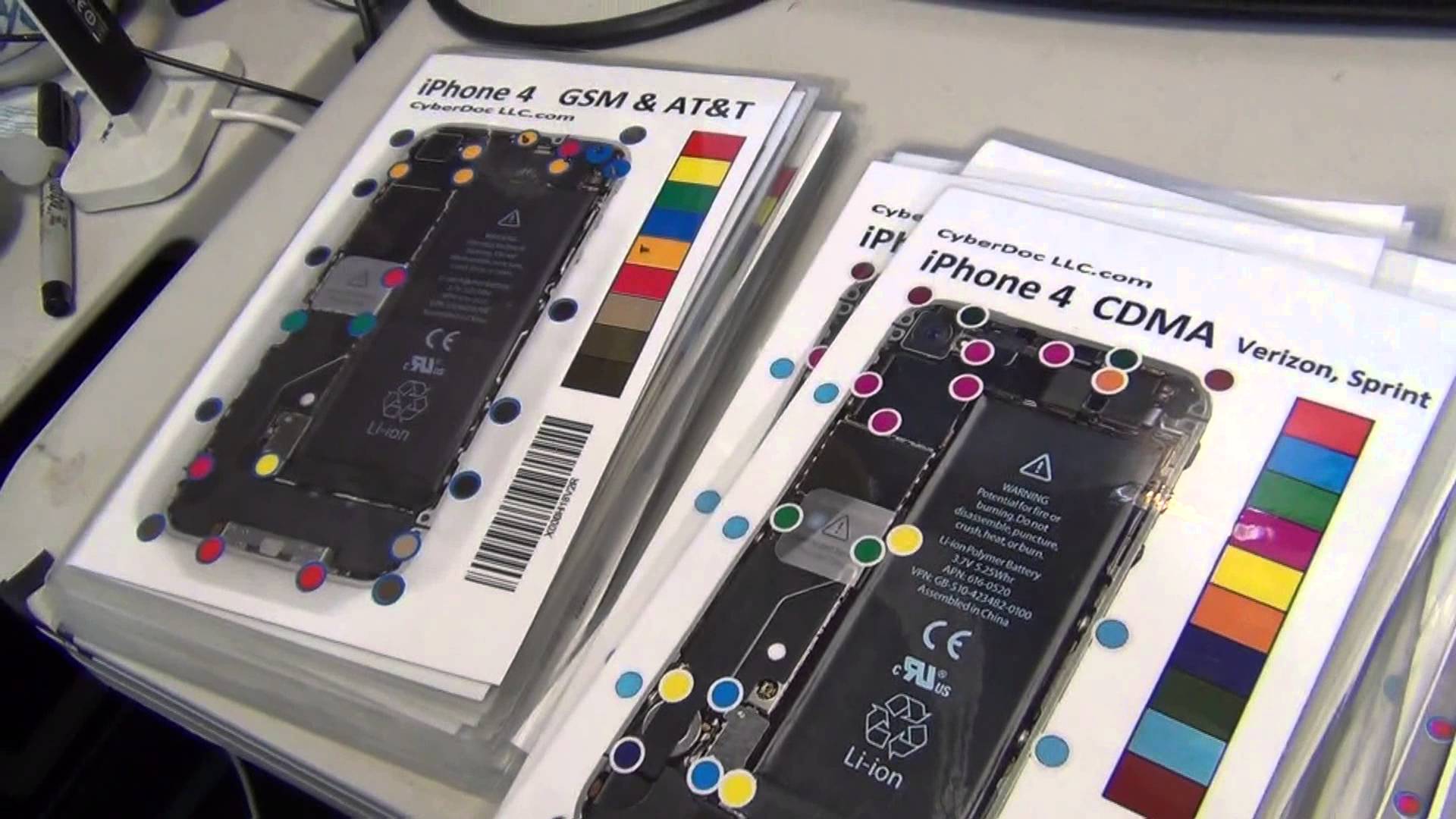
Author/Copyright holder: CyberDoc LLC . Copyright terms and licence: Fair Use.
When production is complete the EPM will take possession of some or all of the test devices and then take them back to Apple’s headquarters at Cupertino.
This is a very costly approach but it’s one of the reasons that Apple has a reputation for quality. The more you invest in design, the more likely you are to build incredible market changing products. It’s the process that the iPod, the iPhone and the iPad went through.
The Packaging Room
This is a very-high security area in Apple and it’s where prototypes are unboxed. As you might expect, the security is to prevent leaks to the outside world. If you ever do see a leaked prototype for an Apple product – it won’t have come from here. It’s more likely to have vanished from a production line in China.
A Launch Plan

Author/Copyright holder: Manutaus. Copyright terms and licence: CC BY-SA 3.0
The final step in Apple’s product development is product launch. When the product is considered to be as good as it can be – it enters an action plan known as “the Rules of the Road”. This explains all the responsibilities and actions that must be taken prior to a commercial launch of the product.
It must be a nerve-wracking experience to be privy to the “Rules of the Road” because if you lose it or leak it… you’re immediately fired. This is explained in the document itself.
The Take Away
Apple’s process is complex, expensive and demanding. If you compare it to most business theories – it shouldn’t work. However, to date it has out-performed even the wildest of expectations.
You may not be able to emulate all of their processes within the space of your own workplace but there’s no reason that you can’t develop written processes for design phases and launch phases of your projects, for example. And, of course , there is no reason at all for you in not iterating!
The more you know about successful design processes, the more you can take some of the best aspects of them and use them to enhance your own products.
Find out all the details of the design process in: Inside Apple: How America's Most Admired--and Secretive--Company Really Works by Adam Lashinsky ISBN 97814555512157, Published January 25, 2012
And take an insight into Apple’s greatest designer’s mind in : JonyIve: The Genius Behind Apple's Greatest Products by Leander Kahney ISBN 159184617X, Published November 14, 2013
Hero Image: Author/Copyright holder: Sreejithk2000. Copyright terms and licence: Public Domain.
Design Thinking: The Ultimate Guide

Get Weekly Design Tips
Topics in this article, what you should read next, what is interaction design.

- 1.4k shares
How to Change Your Career from Graphic Design to UX Design

Shneiderman’s Eight Golden Rules Will Help You Design Better Interfaces

- 1.3k shares
The Principles of Service Design Thinking - Building Better Services

A Simple Introduction to Lean UX

- 3 years ago
Dieter Rams: 10 Timeless Commandments for Good Design

- 4 years ago
The 7 Factors that Influence User Experience

- 1.2k shares
Adaptive vs. Responsive Design

The Grid System: Building a Solid Design Layout

10 Free-to-Use Wireframing Tools [Updated for 2024]

Open Access—Link to us!
We believe in Open Access and the democratization of knowledge . Unfortunately, world-class educational materials such as this page are normally hidden behind paywalls or in expensive textbooks.
If you want this to change , cite this article , link to us, or join us to help us democratize design knowledge !
Privacy Settings
Our digital services use necessary tracking technologies, including third-party cookies, for security, functionality, and to uphold user rights. Optional cookies offer enhanced features, and analytics.
Experience the full potential of our site that remembers your preferences and supports secure sign-in.
Governs the storage of data necessary for maintaining website security, user authentication, and fraud prevention mechanisms.
Enhanced Functionality
Saves your settings and preferences, like your location, for a more personalized experience.
Referral Program
We use cookies to enable our referral program, giving you and your friends discounts.
Error Reporting
We share user ID with Bugsnag and NewRelic to help us track errors and fix issues.
Optimize your experience by allowing us to monitor site usage. You’ll enjoy a smoother, more personalized journey without compromising your privacy.
Analytics Storage
Collects anonymous data on how you navigate and interact, helping us make informed improvements.
Differentiates real visitors from automated bots, ensuring accurate usage data and improving your website experience.
Lets us tailor your digital ads to match your interests, making them more relevant and useful to you.
Advertising Storage
Stores information for better-targeted advertising, enhancing your online ad experience.
Personalization Storage
Permits storing data to personalize content and ads across Google services based on user behavior, enhancing overall user experience.
Advertising Personalization
Allows for content and ad personalization across Google services based on user behavior. This consent enhances user experiences.
Enables personalizing ads based on user data and interactions, allowing for more relevant advertising experiences across Google services.
Receive more relevant advertisements by sharing your interests and behavior with our trusted advertising partners.
Enables better ad targeting and measurement on Meta platforms, making ads you see more relevant.
Allows for improved ad effectiveness and measurement through Meta’s Conversions API, ensuring privacy-compliant data sharing.
LinkedIn Insights
Tracks conversions, retargeting, and web analytics for LinkedIn ad campaigns, enhancing ad relevance and performance.
LinkedIn CAPI
Enhances LinkedIn advertising through server-side event tracking, offering more accurate measurement and personalization.
Google Ads Tag
Tracks ad performance and user engagement, helping deliver ads that are most useful to you.
Share Knowledge, Get Respect!
or copy link
Cite according to academic standards
Simply copy and paste the text below into your bibliographic reference list, onto your blog, or anywhere else. You can also just hyperlink to this article.
New to UX Design? We’re giving you a free ebook!

Download our free ebook The Basics of User Experience Design to learn about core concepts of UX design.
In 9 chapters, we’ll cover: conducting user interviews, design thinking, interaction design, mobile UX design, usability, UX research, and many more!
New to UX Design? We’re Giving You a Free ebook!
- SUGGESTED TOPICS
- The Magazine
- Newsletters
- Managing Yourself
- Managing Teams
- Work-life Balance
- The Big Idea
- Data & Visuals
- Reading Lists
- Case Selections
- HBR Learning
- Topic Feeds
- Account Settings
- Email Preferences
How Apple Is Organized for Innovation
- Joel M. Podolny
- Morten T. Hansen

When Steve Jobs returned to Apple, in 1997, it had a conventional structure for a company of its size and scope. It was divided into business units, each with its own P&L responsibilities. Believing that conventional management had stifled innovation, Jobs laid off the general managers of all the business units (in a single day), put the entire company under one P&L, and combined the disparate functional departments of the business units into one functional organization. Although such a structure is common for small entrepreneurial firms, Apple—remarkably—retains it today, even though the company is nearly 40 times as large in terms of revenue and far more complex than it was in 1997. In this article the authors discuss the innovation benefits and leadership challenges of Apple’s distinctive and ever-evolving organizational model in the belief that it may be useful for other companies competing in rapidly changing environments.
It’s about experts leading experts.
Idea in Brief
The challenge.
Major companies competing in many industries struggle to stay abreast of rapidly changing technologies.
One Major Cause
They are typically organized into business units, each with its own set of functions. Thus the key decision makers—the unit leaders—lack a deep understanding of all the domains that answer to them.
The Apple Model
The company is organized around functions, and expertise aligns with decision rights. Leaders are cross-functionally collaborative and deeply knowledgeable about details.
Apple is well-known for its innovations in hardware, software, and services. Thanks to them, it grew from some 8,000 employees and $7 billion in revenue in 1997, the year Steve Jobs returned, to 137,000 employees and $260 billion in revenue in 2019. Much less well-known are the organizational design and the associated leadership model that have played a crucial role in the company’s innovation success.
- Joel M. Podolny is the dean and vice president of Apple University in Cupertino, California. The former dean of the Yale School of Management, Podolny was a professor at Harvard Business School and the Stanford Graduate School of Business.
- MH Morten T. Hansen is a professor at the University of California, Berkeley, and a faculty member at Apple University, Apple. He is the author of Great at Work and Collaboration and coauthor of Great by Choice . He was named one of the top management thinkers in the world by the Thinkers50 in 2019. MortentHansen
Partner Center

- International Marketing
Apple’s Global Strategy: Simplicity, Innovation, and Adaptability
- January 19, 2024
- LinkedIn 29
Table of Contents
Delving into apple’s global strategy, apple’s core values and the simplicity mantra, apple’s global branding strategy, apple’s global marketing strategy, case studies, apple’s global tax strategy.
- The Cornerstones of Apple’s Global Strateg
In the ever-evolving landscape of technology, Apple stands as a beacon of innovation and design, captivating consumers worldwide with its sleek products and user-centric approach. With a global presence spanning over 150 countries and an estimated $383.29 billion in revenue in 2023, according to Statista , Apple’s success is a testament to its astute global strategy , a harmonious blend of differentiation, adaptability, and unwavering commitment to quality.
Apple’s global strategy is rooted in the concept of “differentiation,” a strategic approach that sets it apart from its competitors. By consistently pushing the boundaries of innovation, Apple has carved a niche for itself, offering products that are not only technologically advanced but also aesthetically pleasing and user-friendly . This differentiation has allowed Apple to capture a loyal customer base and establish a strong brand identity across the globe .
Apple’s global strategy has evolved over time, adapting to the changing dynamics of the international market. In its early days, the company focused heavily on innovation, relentlessly pursuing cutting-edge technologies and groundbreaking designs. However, as the company matured, it recognized the importance of customer experience and began placing a greater emphasis on this aspect . Today, Apple’s global strategy is a seamless blend of innovation and customer focus, ensuring that its products and services align with the needs and preferences of consumers worldwide.
At the heart of Apple’s global success lies a set of core values that permeate every aspect of the company’s operations , from product design to marketing campaigns. These values, deeply rooted in the company’s identity, guide Apple’s approach to innovation, customer experience, and global expansion.
- Accessibility: Apple strives to make its products and services accessible to everyone, regardless of their physical or cognitive abilities. This commitment is evident in features like VoiceOver , which provides spoken feedback for visually impaired users, and AssistiveTouch , which allows users with limited mobility to control devices with gestures.
- Educational Support: Apple recognizes the transformative power of technology in education and actively supports initiatives that promote digital literacy and learning. The company’s initiatives include Apple Teacher certification programs, curriculum resources, and educational apps that enhance teaching and learning.
- Carbon Neutrality: Apple is committed to reducing its environmental impact and is working towards becoming carbon neutral by 2030 . The company has implemented numerous initiatives to minimize its carbon footprint, including transitioning to renewable energy sources, designing energy-efficient products, and recycling materials.
- Inclusive Work Environment: Apple is committed to creating a diverse and inclusive workplace where everyone is valued and respected. The company has implemented policies and programs that promote diversity hiring, provide equal opportunities for advancement, and foster a culture of inclusion.
- Privacy: Apple is a staunch advocate for user privacy and believes that individuals should have control over their personal data. The company has implemented robust privacy protections in its products and services, including encryption, data minimization, and transparency.
- Equity and Justice: Apple is committed to promoting equity and justice in its operations and throughout the world. The company supports initiatives that address social and economic inequalities, promotes human rights, and advocates for environmental sustainability.
- Supplier Responsibility: Apple is committed to ensuring that its suppliers adhere to high ethical standards and treat their workers with respect. The company has established stringent supplier codes of conduct and conducts regular audits to monitor compliance.
These core values, collectively, form the foundation of Apple’s global strategy. They guide the company’s product design, marketing campaigns, and customer service interactions , ensuring that Apple delivers products and experiences that are not only technologically advanced but also aligned with its values of simplicity, accessibility, and inclusivity.
Simplicity is a cornerstone of Apple’s design philosophy, evident in the clean aesthetics, intuitive interfaces, and user-friendly features of its products. This emphasis on simplicity has resonated with consumers worldwide , making Apple products accessible to a broad audience and fostering a loyal customer base.
By upholding its core values and embracing simplicity, Apple has not only achieved global success but also established itself as a role model for other companies seeking to build a sustainable and ethical business model.
Apple’s global branding strategy is a delicate balance of standardization and adaptation, ensuring that the company maintains a consistent brand identity while also resonating with consumers in diverse cultures and markets. On the one hand, Apple strives to project a unified brand image, conveying its core values of innovation, simplicity, and elegance across all its products, marketing campaigns, and customer interactions. This standardization helps reinforce Apple’s reputation for quality and consistency, fostering brand loyalty and recognition worldwide.
On the other hand, Apple recognizes the need to adapt its branding to local markets and cultures. This adaptability is evident in the company’s product offerings, marketing messages, and customer support. For instance, Apple has developed localized versions of its products with features and specifications tailored to specific regions . Additionally, the company’s marketing campaigns often incorporate cultural nuances and local references to connect with consumers on a deeper level.
Apple’s ability to balance standardization and adaptation has been a key factor in its global success. By maintaining a consistent brand identity, the company has built a strong foundation of brand recognition and loyalty . However, by adapting to local markets, Apple has been able to cater to the needs and preferences of consumers in different parts of the world, expanding its reach and deepening its customer base.
Examples of Apple’s Standardization
- Unifying Brand Elements: Apple employs a consistent design language across its products, including clean aesthetics, minimalist interfaces, and sleek silhouettes. This consistent visual language helps establish a cohesive brand identity.
- Global Marketing Campaigns: Apple’s marketing campaigns often feature universal themes of innovation, creativity, and personal empowerment, appealing to a global audience.
- Seamless Customer Experience: Apple’s customer support is available in multiple languages, and the company’s online store can be accessed in over 40 countries, ensuring a consistent experience for customers worldwide.
Examples of Apple’s Adaptation
- Localization of Products: Apple offers localized versions of its products, such as the iPhone and iPad, with features and specifications tailored to specific regions. For instance, the iPhone SE 2020 is optimized for Indian consumers with support for two SIM cards and regional cellular bands.
- Culturally Sensitive Marketing: Apple’s marketing campaigns often incorporate cultural nuances and local references to connect with consumers on a deeper level. For example, the company’s “ Shot on iPhone ” campaign features images captured by photographers from around the world, showcasing the diversity of visual storytelling.
- Localized Customer Support: Apple provides customer support in multiple languages and offers localized resources, such as online FAQs and tutorials, tailored to specific regions. The company also partners with local businesses to offer personalized support services.
Apple’s success in balancing standardization and adaptation is a testament to its understanding of the complexities of global branding. By striking this delicate balance, the company has been able to maintain a strong brand identity while also resonating with consumers in diverse markets , solidifying its position as one of the world’s most recognizable brands.
Apple’s global marketing strategy is a multifaceted approach that revolves around four key pillars: wide acceptance, brand value, competitive advantage, and low imitation . These pillars are intertwined, working together to propel Apple’s success in the global marketplace.
Wide Acceptance
Apple’s products have achieved widespread acceptance worldwide, attracting a loyal customer base across diverse demographics and regions . This widespread appeal is attributed to several factors, including:
- Innovative Designs: Apple consistently pushes the boundaries of design, creating products that are both aesthetically pleasing and user-friendly. The company’s sleek, minimalist aesthetic has become synonymous with Apple’s brand identity.
- User-Friendly Interfaces: Apple’s products are renowned for their intuitive interfaces, making them easy to navigate and use for people of all technical backgrounds.
- Effective Marketing Campaigns: Apple’s marketing campaigns are known for their creativity and emotional appeal, resonating with consumers on a personal level. The company often uses storytelling and cultural references to connect with diverse audiences.
Brand Value
Apple has built a strong brand value over the years, characterized by perceptions of quality, innovation, and premium craftsmanship . This brand value has been instrumental in attracting consumers and fostering brand loyalty.
- Reputation for Quality: Apple is consistently rated among the most reliable and durable consumer electronics brands. This reputation for quality has earned the company a loyal following among consumers who value long-lasting products.
- Innovation: Apple is renowned for its pioneering spirit, consistently introducing innovative products that redefine the technological landscape. This focus on innovation has helped maintain Apple’s cutting-edge reputation and attract early adopters.
- Premium Branding: Apple’s products are positioned in the premium segment of the market , commanding higher prices than its competitors. This premium positioning contributes to the company’s brand value and reinforces its image as a luxury brand.
Competitive Advantage
Apple maintains a competitive advantage in the global market through a combination of factors, including:
- Strategic Product Differentiation: Apple differentiates its products from competitors through unique features, design elements, and user experiences. This differentiation strategy has helped the company carve out a distinct niche in the market.
- Focus on Customer Experience: Apple prioritizes customer satisfaction, creating a seamless and personalized experience for its users. This focus on customer experience has helped foster brand loyalty and attract new customers.
- Global Retail Presence: Apple has a strong global retail presence, with over 500 stores in 23 countries, as per Statista . This extensive retail network provides consumers with easy access to Apple products and services.
Low Imitation
Despite facing intense competition from numerous technology giants, Apple has been able to maintain a relatively low level of imitation . This is due to several factors, including:
- Continuous Innovation: Apple’s relentless pursuit of innovation makes it difficult for competitors to replicate its products and services.
- Strengthened Intellectual Property Protection: Apple has a robust intellectual property portfolio, providing legal protection for its innovative designs and technologies.
- Brand Loyalty: Apple’s loyal customer base is less susceptible to imitation, as they are often willing to pay a premium for Apple products due to their brand loyalty and trust in the company.
Apple’s successful global marketing strategy is a testament to its ability to balance innovation, brand value, competitive advantage, and low imitation. By consistently delivering high-quality products, cultivating a strong brand reputation, and prioritizing customer experience, Apple has cemented its position as one of the world’s leading technology companies .
Apple’s remarkable global success is evident in its ability to penetrate and dominate markets as diverse as China and India. These two countries represent two of the world’s most populous and rapidly growing economies, offering significant opportunities for technology companies. Apple’s success in these markets is a testament to its ability to adapt its global strategy to local conditions and preferences .
China has become Apple’s second-largest market , with over 190 million active iPhones in use as of 2023 ( Statista , 2023). Apple’s success in China can be attributed to several factors, including:
- Pricing Strategy: Apple has adopted a tiered pricing strategy in China, offering a wider range of products at lower price points to cater to a broader range of consumers.
- Distribution Channels: Apple has established a strong network of authorized resellers and retail stores in China, making its products readily available to consumers across the country.
- Partnerships with Local Businesses: Apple has partnered with Chinese telecommunications companies, e-commerce platforms, and content providers to expand its reach and customer base.
- Localization: Apple has made sure to localize its products , marketing campaigns, and customer support for the Chinese market, ensuring that they resonate with local consumers.
Despite facing challenges such as piracy and counterfeiting, Apple has successfully established itself as a premium brand in China . The company’s commitment to innovation, design, and customer experience has resonated with Chinese consumers, who are increasingly embracing technology.
India is another key market for Apple, with a growing middle class and increasing smartphone penetration. Apple’s strategy in India has focused on tailoring its products and services to the specific needs and preferences of Indian consumers .
- Price Sensitivity: Apple has introduced more affordable iPhone models in India, such as the iPhone SE, to attract price-conscious consumers.
- Online Sales: Apple has heavily invested in its online presence in India, making it easier for consumers to purchase its products online.
- Partnerships with Local Businesses: Apple has partnered with Indian e-commerce platforms, mobile carriers, and banks to expand its distribution reach and payment options.
- Localization: Apple’s localization strategy for the Indian market has included the adaptation of its products, marketing campaigns, and customer support, including the development of Hindi-language versions of its software.
Apple’s success in India has been gradual but steady. The company has faced challenges such as competition from local smartphone brands and a lack of brand recognition in rural areas. However, Apple’s commitment to innovation and adaptation has helped it gain traction in this emerging market .
Apple’s global success has been accompanied by scrutiny over its tax practices, particularly its use of a subsidiary company in Ireland to minimize its global tax liability. This strategy, known as “ Double Irish with a Dutch Sandwich ,” has allowed Apple to shift profits offshore, effectively reducing its tax payments in the United States and other countries .
While Apple has defended its tax strategy, arguing that it complies with all applicable laws, it has faced criticism from governments, tax experts, and consumer advocacy groups . Critics argue that Apple’s tax practices amount to corporate tax avoidance, depriving governments of revenue that could be used for public services.
Advantages of Apple’s Tax Strategy
Apple’s tax strategy has several potential advantages for the company, including:
- Reduced Tax Burden: By shifting profits offshore, Apple can effectively reduce its tax payments, which can boost its profitability and financial returns to shareholders.
- Increased Competitiveness: Lowering tax costs can give Apple a competitive advantage over other companies, allowing it to invest more in research and development, marketing, and product development.
- Enhanced Shareholder Value: By reducing its tax burden and increasing profitability, Apple can improve its financial performance and boost shareholder value.
Disadvantages of Apple’s Tax Strategy
Apple’s tax strategy has also been criticized for several potential disadvantages, including:
- Public Image Concerns: Apple’s tax practices have tarnished its public image, raising concerns about corporate social responsibility and ethical behavior.
- Legal Challenges: Governments and tax authorities around the world have been investigating Apple’s tax strategy, and the company faces potential legal challenges that could lead to fines and penalties.
- Political Fallout: Apple’s tax practices have created political tensions, with some countries considering imposing stricter tax laws to prevent multinational corporations from shifting profits offshore.
A Balancing Act
Apple’s global tax strategy has been a source of controversy, highlighting the delicate balance between corporate profitability and societal responsibility . While the company may benefit financially from its tax practices, it also faces reputational risks and potential legal repercussions. Apple must carefully navigate this complex landscape to maintain its global success while addressing concerns about its ethical conduct.
The Cornerstones of Apple’s Global Strategy
Apple’s journey to becoming one of the world’s most recognizable and successful companies is a testament to its ability to balance simplicity, innovation, and adaptability. From its early days as a niche computer manufacturer to its current status as a global technology powerhouse, Apple has consistently demonstrated its knack for understanding and meeting the evolving needs of consumers worldwide .
Apple’s core values, particularly its emphasis on simplicity, have permeated every aspect of its business. The company’s products are renowned for their user-friendly interfaces and intuitive designs , making them accessible to a wide range of users, regardless of their technical expertise. This commitment to simplicity extends to Apple’s marketing campaigns, which often use storytelling and emotional appeals to resonate with consumers on a personal level.
Apple’s unwavering focus on innovation has been another driving force behind its global success. The company has consistently pushed the boundaries of technology, introducing groundbreaking products that have transformed the way people interact with the digital world . From the revolutionary iPhone to the sleek AirPods, Apple has consistently redefined the standards for innovation in the technology industry.
Alongside innovation and simplicity, Apple has also demonstrated remarkable adaptability in its global expansion . The company has successfully tailored its products, marketing strategies, and customer support to suit the unique needs and preferences of different cultures. This adaptability has been crucial in Apple’s ability to penetrate and dominate markets as diverse as China and India, where local competitors pose significant challenges.
Apple’s approach to globalization is not without its critics. The company’s tax strategy, which has been the subject of intense scrutiny, has raised concerns about corporate social responsibility and ethical behavior. As Apple continues to expand its global footprint, it will need to address these concerns and demonstrate its commitment to operating responsibly and ethically in all the markets it serves.
Looking to the future, Apple faces a number of challenges and opportunities. The company will need to continue to innovate and adapt to the ever-changing technological landscape . It will also need to navigate the complexities of global markets, ensuring that its products and services remain relevant and appealing to consumers worldwide.
Apple’s journey to global success is a compelling case study in how a company can build a strong brand and establish a lasting presence in the international arena. By embracing simplicity, innovation, and adaptability, Apple has demonstrated that it has the vision and resilience to continue to thrive in an increasingly competitive and interconnected world .
As Apple embarks on the next chapter of its global journey, it remains to be seen how the company will navigate the evolving landscape of technology, consumerism, and globalization. However, one thing is certain: Apple’s commitment to innovation and its ability to understand the needs of consumers worldwide will continue to be key drivers of its success in the years to come.

Privacy Preferences
When you visit our website, it may store information through your browser from specific services, usually in the form of cookies. Here you can change your Privacy preferences. It is worth noting that blocking some types of cookies may impact your experience on our website and the services we are able to offer.
About Stanford GSB
- The Leadership
- Dean’s Updates
- School News & History
- Commencement
- Business, Government & Society
- Centers & Institutes
- Center for Entrepreneurial Studies
- Center for Social Innovation
- Stanford Seed
About the Experience
- Learning at Stanford GSB
- Experiential Learning
- Guest Speakers
- Entrepreneurship
- Social Innovation
- Communication
- Life at Stanford GSB
- Collaborative Environment
- Activities & Organizations
- Student Services
- Housing Options
- International Students
Full-Time Degree Programs
- Why Stanford MBA
- Academic Experience
- Financial Aid
- Why Stanford MSx
- Research Fellows Program
- See All Programs
Non-Degree & Certificate Programs
- Executive Education
- Stanford Executive Program
- Programs for Organizations
- The Difference
- Online Programs
- Stanford LEAD
- Seed Transformation Program
- Aspire Program
- Seed Spark Program
- Faculty Profiles
- Academic Areas
- Awards & Honors
- Conferences
Faculty Research
- Publications
- Working Papers
- Case Studies
Research Hub
- Research Labs & Initiatives
- Business Library
- Data, Analytics & Research Computing
- Behavioral Lab
Research Labs
- Cities, Housing & Society Lab
- Golub Capital Social Impact Lab
Research Initiatives
- Corporate Governance Research Initiative
- Corporations and Society Initiative
- Policy and Innovation Initiative
- Rapid Decarbonization Initiative
- Stanford Latino Entrepreneurship Initiative
- Value Chain Innovation Initiative
- Venture Capital Initiative
- Career & Success
- Climate & Sustainability
- Corporate Governance
- Culture & Society
- Finance & Investing
- Government & Politics
- Leadership & Management
- Markets and Trade
- Operations & Logistics
- Opportunity & Access
- Technology & AI
- Opinion & Analysis
- Email Newsletter
Welcome, Alumni
- Communities
- Digital Communities & Tools
- Regional Chapters
- Women’s Programs
- Identity Chapters
- Find Your Reunion
- Career Resources
- Job Search Resources
- Career & Life Transitions
- Programs & Webinars
- Career Video Library
- Alumni Education
- Research Resources
- Volunteering
- Alumni News
- Class Notes
- Alumni Voices
- Contact Alumni Relations
- Upcoming Events
Admission Events & Information Sessions
- MBA Program
- MSx Program
- PhD Program
- Alumni Events
- All Other Events
- Operations, Information & Technology
- Organizational Behavior
- Political Economy
- Classical Liberalism
- The Eddie Lunch
- Accounting Summer Camp
- California Econometrics Conference
- California Quantitative Marketing PhD Conference
- California School Conference
- China India Insights Conference
- Homo economicus, Evolving
- Political Economics (2023–24)
- Scaling Geologic Storage of CO2 (2023–24)
- A Resilient Pacific: Building Connections, Envisioning Solutions
- Adaptation and Innovation
- Changing Climate
- Civil Society
- Climate Impact Summit
- Climate Science
- Corporate Carbon Disclosures
- Earth’s Seafloor
- Environmental Justice
- Operations and Information Technology
- Organizations
- Sustainability Reporting and Control
- Taking the Pulse of the Planet
- Urban Infrastructure
- Watershed Restoration
- Junior Faculty Workshop on Financial Regulation and Banking
- Ken Singleton Celebration
- Marketing Camp
- Quantitative Marketing PhD Alumni Conference
- Presentations
- Theory and Inference in Accounting Research
- Stanford Closer Look Series
- Quick Guides
- Core Concepts
- Journal Articles
- Glossary of Terms
- Faculty & Staff
- Researchers & Students
- Research Approach
- Charitable Giving
- Financial Health
- Government Services
- Workers & Careers
- Short Course
- Adaptive & Iterative Experimentation
- Incentive Design
- Social Sciences & Behavioral Nudges
- Bandit Experiment Application
- Conferences & Events
- Get Involved
- Reading Materials
- Teaching & Curriculum
- Energy Entrepreneurship
- Faculty & Affiliates
- SOLE Report
- Responsible Supply Chains
- Current Study Usage
- Pre-Registration Information
- Participate in a Study
The Rise of Apple
Learning objective.

- See the Current DEI Report
- Supporting Data
- Research & Insights
- Share Your Thoughts
- Search Fund Primer
- Affiliated Faculty
- Faculty Advisors
- Louis W. Foster Resource Center
- Defining Social Innovation
- Impact Compass
- Global Health Innovation Insights
- Faculty Affiliates
- Student Awards & Certificates
- Changemakers
- Dean Jonathan Levin
- Dean Garth Saloner
- Dean Robert Joss
- Dean Michael Spence
- Dean Robert Jaedicke
- Dean Rene McPherson
- Dean Arjay Miller
- Dean Ernest Arbuckle
- Dean Jacob Hugh Jackson
- Dean Willard Hotchkiss
- Faculty in Memoriam
- Stanford GSB Firsts
- Class of 2024 Candidates
- Certificate & Award Recipients
- Dean’s Remarks
- Keynote Address
- Teaching Approach
- Analysis and Measurement of Impact
- The Corporate Entrepreneur: Startup in a Grown-Up Enterprise
- Data-Driven Impact
- Designing Experiments for Impact
- Digital Marketing
- The Founder’s Right Hand
- Marketing for Measurable Change
- Product Management
- Public Policy Lab: Financial Challenges Facing US Cities
- Public Policy Lab: Homelessness in California
- Lab Features
- Curricular Integration
- View From The Top
- Formation of New Ventures
- Managing Growing Enterprises
- Startup Garage
- Explore Beyond the Classroom
- Stanford Venture Studio
- Summer Program
- Workshops & Events
- The Five Lenses of Entrepreneurship
- Leadership Labs
- Executive Challenge
- Arbuckle Leadership Fellows Program
- Selection Process
- Training Schedule
- Time Commitment
- Learning Expectations
- Post-Training Opportunities
- Who Should Apply
- Introductory T-Groups
- Leadership for Society Program
- Certificate
- 2024 Awardees
- 2023 Awardees
- 2022 Awardees
- 2021 Awardees
- 2020 Awardees
- 2019 Awardees
- 2018 Awardees
- Social Management Immersion Fund
- Stanford Impact Founder Fellowships
- Stanford Impact Leader Prizes
- Social Entrepreneurship
- Stanford GSB Impact Fund
- Economic Development
- Energy & Environment
- Stanford GSB Residences
- Environmental Leadership
- Stanford GSB Artwork
- A Closer Look
- California & the Bay Area
- Voices of Stanford GSB
- Business & Beneficial Technology
- Business & Sustainability
- Business & Free Markets
- Business, Government, and Society Forum
- Second Year
- Global Experiences
- JD/MBA Joint Degree
- MA Education/MBA Joint Degree
- MD/MBA Dual Degree
- MPP/MBA Joint Degree
- MS Computer Science/MBA Joint Degree
- MS Electrical Engineering/MBA Joint Degree
- MS Environment and Resources (E-IPER)/MBA Joint Degree
- Academic Calendar
- Clubs & Activities
- LGBTQ+ Students
- Military Veterans
- Minorities & People of Color
- Partners & Families
- Students with Disabilities
- Student Support
- Residential Life
- Student Voices
- MBA Alumni Voices
- A Week in the Life
- Career Support
- Employment Outcomes
- Cost of Attendance
- Knight-Hennessy Scholars Program
- Yellow Ribbon Program
- BOLD Fellows Fund
- Application Process
- Loan Forgiveness
- Contact the Financial Aid Office
- Evaluation Criteria
- GMAT & GRE
- English Language Proficiency
- Personal Information, Activities & Awards
- Professional Experience
- Letters of Recommendation
- Optional Short Answer Questions
- Application Fee
- Reapplication
- Deferred Enrollment
- Joint & Dual Degrees
- Entering Class Profile
- Event Schedule
- Ambassadors
- New & Noteworthy
- Ask a Question
- See Why Stanford MSx
- Is MSx Right for You?
- MSx Stories
- Leadership Development
- How You Will Learn
- Admission Events
- Personal Information
- GMAT, GRE & EA
- English Proficiency Tests
- Career Change
- Career Advancement
- Daycare, Schools & Camps
- U.S. Citizens and Permanent Residents
- Requirements
- Requirements: Behavioral
- Requirements: Quantitative
- Requirements: Macro
- Requirements: Micro
- Annual Evaluations
- Field Examination
- Research Activities
- Research Papers
- Dissertation
- Oral Examination
- Current Students
- Education & CV
- International Applicants
- Statement of Purpose
- Reapplicants
- Application Fee Waiver
- Deadline & Decisions
- Job Market Candidates
- Academic Placements
- Stay in Touch
- Faculty Mentors
- Current Fellows
- Standard Track
- Fellowship & Benefits
- Group Enrollment
- Program Formats
- Developing a Program
- Diversity & Inclusion
- Strategic Transformation
- Program Experience
- Contact Client Services
- Campus Experience
- Live Online Experience
- Silicon Valley & Bay Area
- Digital Credentials
- Faculty Spotlights
- Participant Spotlights
- Eligibility
- International Participants
- Stanford Ignite
- Frequently Asked Questions
- Founding Donors
- Location Information
- Participant Profile
- Network Membership
- Program Impact
- Collaborators
- Entrepreneur Profiles
- Company Spotlights
- Seed Transformation Network
- Responsibilities
- Current Coaches
- How to Apply
- Meet the Consultants
- Meet the Interns
- Intern Profiles
- Collaborate
- Research Library
- News & Insights
- Program Contacts
- Databases & Datasets
- Research Guides
- Consultations
- Research Workshops
- Career Research
- Research Data Services
- Course Reserves
- Course Research Guides
- Material Loan Periods
- Fines & Other Charges
- Document Delivery
- Interlibrary Loan
- Equipment Checkout
- Print & Scan
- MBA & MSx Students
- PhD Students
- Other Stanford Students
- Faculty Assistants
- Research Assistants
- Stanford GSB Alumni
- Telling Our Story
- Staff Directory
- Site Registration
- Alumni Directory
- Alumni Email
- Privacy Settings & My Profile
- Success Stories
- The Story of Circles
- Support Women’s Circles
- Stanford Women on Boards Initiative
- Alumnae Spotlights
- Insights & Research
- Industry & Professional
- Entrepreneurial Commitment Group
- Recent Alumni
- Half-Century Club
- Fall Reunions
- Spring Reunions
- MBA 25th Reunion
- Half-Century Club Reunion
- Faculty Lectures
- Ernest C. Arbuckle Award
- Alison Elliott Exceptional Achievement Award
- ENCORE Award
- Excellence in Leadership Award
- John W. Gardner Volunteer Leadership Award
- Robert K. Jaedicke Faculty Award
- Jack McDonald Military Service Appreciation Award
- Jerry I. Porras Latino Leadership Award
- Tapestry Award
- Student & Alumni Events
- Executive Recruiters
- Interviewing
- Land the Perfect Job with LinkedIn
- Negotiating
- Elevator Pitch
- Email Best Practices
- Resumes & Cover Letters
- Self-Assessment
- Whitney Birdwell Ball
- Margaret Brooks
- Bryn Panee Burkhart
- Margaret Chan
- Ricki Frankel
- Peter Gandolfo
- Cindy W. Greig
- Natalie Guillen
- Carly Janson
- Sloan Klein
- Sherri Appel Lassila
- Stuart Meyer
- Tanisha Parrish
- Virginia Roberson
- Philippe Taieb
- Michael Takagawa
- Terra Winston
- Johanna Wise
- Debbie Wolter
- Rebecca Zucker
- Complimentary Coaching
- Changing Careers
- Work-Life Integration
- Career Breaks
- Flexible Work
- Encore Careers
- Join a Board
- D&B Hoovers
- Data Axle (ReferenceUSA)
- EBSCO Business Source
- Global Newsstream
- Market Share Reporter
- ProQuest One Business
- RKMA Market Research Handbook Series
- Student Clubs
- Entrepreneurial Students
- Stanford GSB Trust
- Alumni Community
- How to Volunteer
- Springboard Sessions
- Consulting Projects
- 2020 – 2029
- 2010 – 2019
- 2000 – 2009
- 1990 – 1999
- 1980 – 1989
- 1970 – 1979
- 1960 – 1969
- 1950 – 1959
- 1940 – 1949
- Service Areas
- ACT History
- ACT Awards Celebration
- ACT Governance Structure
- Building Leadership for ACT
- Individual Leadership Positions
- Leadership Role Overview
- Purpose of the ACT Management Board
- Contact ACT
- Business & Nonprofit Communities
- Reunion Volunteers
- Ways to Give
- Fiscal Year Report
- Business School Fund Leadership Council
- Planned Giving Options
- Planned Giving Benefits
- Planned Gifts and Reunions
- Legacy Partners
- Giving News & Stories
- Giving Deadlines
- Development Staff
- Submit Class Notes
- Class Secretaries
- Board of Directors
- Health Care
- Sustainability
- Class Takeaways
- All Else Equal: Making Better Decisions
- If/Then: Business, Leadership, Society
- Grit & Growth
- Think Fast, Talk Smart
- Spring 2022
- Spring 2021
- Autumn 2020
- Summer 2020
- Winter 2020
- In the Media
- For Journalists
- DCI Fellows
- Other Auditors
- Academic Calendar & Deadlines
- Course Materials
- Entrepreneurial Resources
- Campus Drive Grove
- Campus Drive Lawn
- CEMEX Auditorium
- King Community Court
- Seawell Family Boardroom
- Stanford GSB Bowl
- Stanford Investors Common
- Town Square
- Vidalakis Courtyard
- Vidalakis Dining Hall
- Catering Services
- Policies & Guidelines
- Reservations
- Contact Faculty Recruiting
- Lecturer Positions
- Postdoctoral Positions
- Accommodations
- CMC-Managed Interviews
- Recruiter-Managed Interviews
- Virtual Interviews
- Campus & Virtual
- Search for Candidates
- Think Globally
- Recruiting Calendar
- Recruiting Policies
- Full-Time Employment
- Summer Employment
- Entrepreneurial Summer Program
- Global Management Immersion Experience
- Social-Purpose Summer Internships
- Process Overview
- Project Types
- Client Eligibility Criteria
- Client Screening
- ACT Leadership
- Social Innovation & Nonprofit Management Resources
- Develop Your Organization’s Talent
- Centers & Initiatives
- Student Fellowships

Case Study: Apple’s Development and Management of the iPhone
Introduction
Apple Inc. has set a gold standard in product development and management with its flagship product, the iPhone. Since its launch in 2007, the iPhone has revolutionized the smartphone industry and become one of the most successful consumer products in history. This case study examines Apple’s strategic approach to developing and managing the iPhone, highlighting key aspects such as innovation, branding, product lifecycle management, and marketing strategies.
Apple Inc., founded in 1976 by Steve Jobs, Steve Wozniak, and Ronald Wayne, initially focused on personal computers before expanding into consumer electronics. The introduction of the iPhone in 2007 marked a significant shift in Apple’s product strategy and positioned the company as a leader in the smartphone market.
The iPhone combined a phone, an iPod, and an internet communicator into one device, a concept that was groundbreaking at the time. Apple’s focus on sleek design, user-friendly interface, and a robust ecosystem of apps and services differentiated the iPhone from its competitors and quickly made it a market leader.
Product Development Strategy
Innovation and Design:
- Apple’s product development strategy for the iPhone centers around innovation and design. The company emphasizes creating products that are not only functional but also aesthetically pleasing. The iPhone’s design has consistently been one of its most praised features, with its minimalist design and intuitive user interface setting it apart from other smartphones.
- Apple’s focus on integrating hardware and software has been a key factor in the iPhone’s success. The company controls every aspect of the product, from the design of the hardware to the development of the operating system (iOS), ensuring a seamless user experience.
Product Lifecycle Management:
- Apple has mastered the art of managing the product lifecycle, regularly updating the iPhone with new features, designs, and technologies. The company follows a consistent annual release schedule, introducing new models with incremental improvements and major innovations.
- Apple’s product lifecycle management also includes a clear strategy for phasing out older models, which helps to drive demand for new products while maintaining a sense of exclusivity and cutting-edge technology.
Branding and Marketing:
- The iPhone’s branding is synonymous with quality, innovation, and prestige. Apple’s marketing strategy focuses on creating a strong emotional connection with consumers, emphasizing the iPhone’s role in enhancing the user’s lifestyle.
- Apple’s marketing campaigns are often centered around simplicity and the product’s ability to “just work.” The company uses a combination of product-centric advertising and storytelling to highlight how the iPhone can improve the lives of its users.
- Apple’s retail strategy, including its iconic Apple Stores, plays a crucial role in the marketing of the iPhone. The stores are designed to provide a unique shopping experience, where customers can try out products and receive personalized service.
Ecosystem and Services:
- The iPhone is at the center of Apple’s broader ecosystem, which includes services like the App Store, iCloud, Apple Music, and Apple Pay. This ecosystem creates a strong incentive for customers to remain within the Apple product family, as it offers a seamless experience across devices.
- Apple’s ecosystem also plays a critical role in customer retention. The company’s ability to integrate hardware, software, and services creates a strong network effect, making it difficult for users to switch to competing products.
Challenges and Responses
Market Saturation and Competition:
- As the smartphone market matured, Apple faced the challenge of market saturation and increased competition from brands like Samsung, Huawei, and Google. To address this, Apple diversified its iPhone lineup with models at different price points, such as the iPhone SE, to reach a broader audience.
- Apple also focused on expanding its presence in emerging markets like China and India, where smartphone penetration was still growing. The company adapted its strategies to cater to the needs and preferences of consumers in these regions.
Innovation Pressure:
- Apple is under constant pressure to innovate with each new iPhone release. Consumers and industry analysts have high expectations, and the company must continuously deliver groundbreaking features to maintain its competitive edge.
- To manage this pressure, Apple invests heavily in research and development, exploring new technologies such as augmented reality, 5G, and improved camera systems to enhance the iPhone’s capabilities.
Supply Chain and Manufacturing:
- Apple’s reliance on a global supply chain poses challenges, particularly in terms of managing costs, quality control, and geopolitical risks. The company has addressed these challenges by building strong relationships with suppliers, diversifying its supply chain, and investing in manufacturing processes.
- Apple’s approach to managing its supply chain also includes a focus on sustainability. The company has made significant efforts to reduce its environmental impact by using recycled materials, improving energy efficiency, and ensuring responsible sourcing of raw materials.
Successes and Impact
- The iPhone has consistently been a market leader, dominating the premium smartphone segment and setting trends for the entire industry. Apple’s strategic approach to product development and management has allowed it to maintain its position as a leader in innovation and consumer satisfaction.
- The iPhone has one of the highest customer retention rates in the industry, with many users upgrading to new models rather than switching to competitors. This loyalty is a testament to the strength of Apple’s brand and the quality of its products.
- The iPhone is Apple’s most profitable product, generating significant revenue and contributing to the company’s status as one of the most valuable companies in the world. The success of the iPhone has also fueled the growth of Apple’s ecosystem and services, further enhancing its financial performance.
Questions for Discussion
How has Apple’s approach to product development and management contributed to the success of the iPhone?
- Discuss the role of innovation, design, and ecosystem integration in Apple’s product strategy.
What challenges does Apple face in maintaining its leadership position in the smartphone market, and how has the company addressed these challenges?
- Explore the impact of competition, market saturation, and innovation pressure on Apple’s strategy.
How does Apple’s branding and marketing strategy for the iPhone differ from that of its competitors?
- Consider the importance of emotional connection, simplicity, and lifestyle branding in Apple’s marketing.
In what ways does Apple’s product lifecycle management contribute to the iPhone’s ongoing success?
- Discuss the significance of regular updates, product differentiation, and phasing out older models.
How does Apple’s ecosystem and services strategy enhance the value of the iPhone and contribute to customer retention?
- Explore the network effects and customer loyalty created by Apple’s integrated ecosystem.
- Isaacson, W. (2011). Steve Jobs . Simon & Schuster. Link
- Gawer, A., & Cusumano, M. A. (2014). Industry Platforms and Ecosystem Innovation: Platforms, Markets and Innovation . Edward Elgar Publishing. Link
- Apple Inc. (2022). Apple Annual Report 2022 . Retrieved from Apple Investor Relations
- Kahney, L. (2013). Jony Ive: The Genius Behind Apple’s Greatest Products . Penguin Books. Link
- Lazonick, W., & Mazzucato, M. (2013). The Risk-Reward Nexus in the Innovation-Inequality Relationship: Who Takes the Risks? Who Gets the Rewards? Industrial and Corporate Change, 22(4), 1093-1128. Link
This case study on Apple’s development and management of the iPhone provides a detailed examination of the company’s product strategy and its impact on the smartphone industry, offering insights into successful product development and lifecycle management in marketing.
Today's Top Posts

Case Study: Agency and Partnership in GreenTech Innovations

Case Study: Enhancing Employee Well-Being at HealthPlus Inc.

Case Study: Dollar Shave Club’s Viral Marketing Success

Case Study: McDonald’s Global Vision in Marketing – “Think Global, Act Local”

Study Guide: Building and Managing a Winning Team-Small Business

Case Study: Google’s Market Dominance and Alleged Anticompetitive Practices

Student Guide: Delivering Effective Presentations with Confidence and Leadership
Related posts.

We'll send you the best business news and case studies on what matters the most to you.
- Terms of Service
- Privacy Policy
- Study Guide
- Industrial Report
- Business News
- Business Ethics
- Business Law
- Communication
- Digital Marketing
- Entrepreneurship
- Human Resource Management
- Organisation Behavior
- Project Management
- Supply Chain Management
- System/ Security
- Tourism & Hospitality
- Mathematics
Welcome, Login to your account.
Welcome, Create your new account
Recover your password.
A password will be e-mailed to you.

Designorate
Design thinking, innovation, user experience and healthcare design
Design Thinking Case Study: Innovation at Apple
Apple is one of the leading companies that is renowned for its unique products and brand. A short talk with an Apple user reveals there is an emotional relation between consumers and Apple products , including every “i” product created in the past two decades.
Why are Apple products different from their competitors’ products? How does Apple manage to achieve innovation in its product families? Answering these questions provides interesting insight into Apple’s history and how it survived its most critical time between 1985 and 1997.
When Steve Jobs returned to Apple after being fired, the company share was only worth US $5 and its future was uncertain. Today, in 2016, Apple’s share price is around US $108 and the company achieved revenues of US $233.7 billion in 2015 with net income of US $53.39 billion. This mini case study sheds light on the role that design thinking and innovation played in helping Steve Jobs rescue Apple with his consumer-driven strategy and vision for the company.
The Hard Times at Apple
The early days of Apple (which was cofounded by Steve Jobs on 1976) are characterized by its first personal computer that was delivered with Apple OS. During this time, Apple was dominating the market because there were no other manufacturers of this type of computer as computers were used only by governments or large companies. However, in 1985, Steve Jobs was forced to leave the company. This marked the start of a chaotic era in the company’s strategy and product development.
In the period 1985-1997, Apple struggled to achieve market success, especially after Jobs’s departure and increasing competition from other giants such as IBM, which decided to enter the PC computers market. During this period, Apple faced number of challenges including:
- Unstable strategy due to the change of executive teams
- Unclear vision about Apple’s competitive strategy, especially after IBM entered the PC market
- Unclear vision about selling OS licenses, which would put the company in competition with Windows operating system
- Large number of failed products (such as Newton PDA) and few successful ones (such as PowerBook)
- Products not unique in the market
- Confusion and uncertainty among Apple consumers, resulting from this strategy

Design Thinking to Fuel Innovation
Apple is one of the leading companies in the field of innovation and this couldn’t have happened without the company adopting design thinking . Design thinking is a solution-oriented process that is used to achieve innovation with considerations about the consumer at the heart of all development stages. Tim Brown, president and CEO of IDEO, defines design thinking as follows: “ Design thinking is a human-centered approach to innovation that draws from the designer’s toolkit to integrate the needs of people, the possibilities of technology, and the requirements for business success. ”
“Most people make the mistake of thinking design is what it looks like. People think it’s this veneer — that the designers are handed this box and told, ‘Make it look good!’ That’s not what we think design is. It’s not just what it looks like and feels like. Design is how it works.” — Steve Jobs
In previous design thinking articles, we explored the different models of design thinking including the IDEO model, d.school model, and IBM design thinking model. Most of these models share the target of achieving innovation through three main factors:
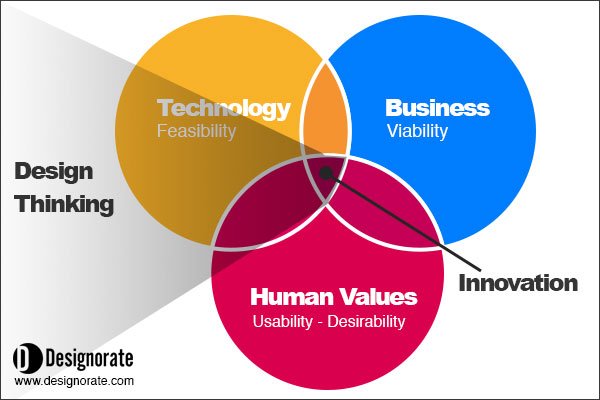
User Desirability . The product should satisfy the consumer’s needs by solving everyday problems through a user-centered process. This can be achieved through a deep understanding of the user and through an empathic design process, which can only be achieved by putting ourselves in the shoes of our consumers (using tools such as an empathic persona map ).
Market Viability . Successful products require an integrated marketing strategy that identifies the target segment and builds the product brand in accordance with this target segment. Tools such as the business model canvas can help our understanding of the project and create a business strategy for it. Also, tools such as the SWOT analysis allows us to understand the strengths, weaknesses, opportunities, and threats of the specified product.
Technology Possibility . Technology provides state-of-art tools for designers to innovate and build products that meet today’s needs. Technology should be adopted through the development process, including the prototyping stage where a visual presentation of the product is made to the team.
Think Different!
After Steve Jobs returned to Apple in 1997 (upon Apple’s acquisition NeXT), he started to apply the design thinking characteristics discussed above, which reflected his vision for Apple products. The vision discussed below was used to form Apple’s strategy from 1997 until today. Steve Jobs applied design thinking by focusing on:
- People’s needs and desires, rather than only the needs of the business
- Building empathy by helping people to love Apple products
- The design rather than the engineering work; designers consider both the form and the function of the product
- Building simple yet user-friendly products rather than complex hard-to-use products
The vision characterized above can be clearly identified in modern Apple products. Although other competitors focus on the features and product capabilities, Apple focuses on a holistic user experience. For example, the iMac is renowned for being quiet, having a quick wake-up, better sound, and a high-quality display. This vision was formed in Apple’s development strategy that includes:
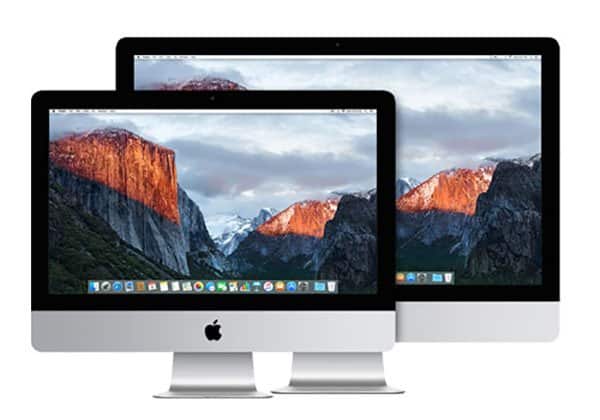
Excellence in Execution
In this part, Steve tended to improve the execution process by closing 2 divisions, eliminating 70% of the new products and focusing on the higher potential products, reducing the product lines from 15 to just 3, and shutting facilities to move manufacturing outside the company. Apple also launched a website for direct sale of its products and started to take an interest in materials and how products are manufactured within a consumer-driven culture.
Platform Strategy
Apple streamlined their product portfolio to a family of products that can be produced much more quickly while keeping the existing design elements. Also, the company targeted product that require less repair and maintenance.
Iterative Customer Involvement
The consumer experience should be integrated into the design and development stages through participating in usability testing. Also, the design for interfaces should focus on the user experience.
Beautiful Products
In addition to the function of the product, the form should beautiful, which can be achieved through continuous innovation and development. Apple also focused on the materials and manufacturing process and took a bold approach to trying new ideas rather than sticking with the ordinary design forms.
Apple’s history with innovation provides a clear lesson about how design and innovation can turn company failure to market success and a leading position in a competitive market. Design thinking helped Apple to innovate while placing their consumers at the heart of the process. The period that Steve Jobs was absent from Apple demonstrates that copying others and lacking a clear innovation strategy can lead companies directly from success to failure. On the other hand, innovation can definitely help build a successful business.
Wait, Join my Newsletters!
As always, I try to come to you with design ideas, tips, and tools for design and creative thinking. Subscribe to my newsletters to receive new updated design tools and tips!
Dr Rafiq Elmansy
As an academic and author, I've had the privilege of shaping the design landscape. I teach design at the University of Leeds and am the Programme Leader for the MA Design, focusing on design thinking, design for health, and behavioural design. I've developed and taught several innovative programmes at Wrexham Glyndwr University, Northumbria University, and The American University in Cairo. I'm also a published book author and the proud founder of Designorate.com, a platform that has been instrumental in fostering design innovation. My expertise in design has been recognised by prestigious organizations. I'm a fellow of the Higher Education Academy (HEA), the Design Research Society (FDRS), and an Adobe Education Leader. Over the course of 20 years, I've had the privilege of working with esteemed clients such as the UN, World Bank, Adobe, and Schneider, contributing to their design strategies. For more than 12 years, I collaborated closely with the Adobe team, playing a key role in the development of many Adobe applications.
You May Also Like
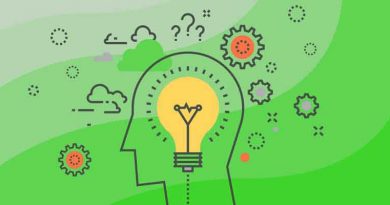
How to Successfully Apply the Inspiration in Design Thinking

How to Use Task Analysis Grid in Service Design

How Designers Can Use Rolestorming to Understand Consumers

How Design Thinking Approaches Problems
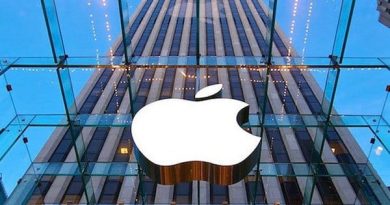
How Does Apple’s Design Process Work?

CATWOE: Building a Problem-Solving Checklist
2 thoughts on “ design thinking case study: innovation at apple ”.
these things is very useful and motivation and thinking about ideas to solve the problems
Thanks Ram!
Leave a Reply Cancel reply
Your email address will not be published. Required fields are marked *
Sign me up for the newsletter!
- Harvard Business School →
- Faculty & Research →
- HBS Case Collection
Apple Inc. in 2020
- Format: Print
- | Language: English
- | Pages: 31
About The Author
David B. Yoffie
Related work.
- December 2020
- Faculty Research
- January 2022
Apple Inc. in 2020 – Select Market Data
- Apple Inc. in 2020 By: David B. Yoffie
- Apple Inc. in 2020 – Select Market Data By: David B. Yoffie

Apple Case Study – How Steve Jobs built Apple around simplicity

Written by Graham Robertson, founder of Beloved Brands
[email protected]
Cal 416 885 3911
Follow me on linkedin, beloved brands book, brand templates.
Our Apple case study starts with 𝘁𝗵𝗲 𝗱𝗮𝘆 𝗦𝘁𝗲𝘃𝗲 𝗝𝗼𝗯𝘀 𝗿𝗲𝘁𝘂𝗿𝗻𝗲𝗱 𝘁𝗼 𝗔𝗽𝗽𝗹𝗲. This is the starting point that 𝘁𝗿𝗮𝗻𝘀𝗳𝗼𝗿𝗺𝗲𝗱 𝗔𝗽𝗽𝗹𝗲 𝗶𝗻𝘁𝗼 𝗼𝗻𝗲 𝗼𝗳 𝘁𝗼𝗱𝗮𝘆’𝘀 𝗺𝗼𝘀𝘁 𝗮𝗱𝗺𝗶𝗿𝗲𝗱 𝗯𝗿𝗮𝗻𝗱 s . Steve Jobs recognized that consumers were frustrated by how all the other technology brands designed their products in a lab without any thought for the consumer. Steve Jobs made the most significant contribution to the Apple brand strategy by starting with the consumer experience and then working back to the technology. The Apple brand positioning builds everything around the idea that “Apple makes technology so simple that everyone can be part of the future.”
Moreover, we witnessed the most incredible decade that any company has ever seen, with Apple launching iTunes, iPod, iMac, the MacBook Pro, MacBook Air, iPhone, and the iPad.
If you are a marketer looking to improve your knowledge by looking at what Apple has done so well, our Apple case study will teach plenty of lessons for using a brand idea to inspire and steer everyone who works on the brand. At every step of the Apple brand strategy, we will provide a link to click on and learn how the process can work on your brand.
If you are a fan of Apple, click on this link to view their best store locations: Apple Store locations . Or come see some of their best advertising: Apple Advertising .

Apple Case Study - Table of Contents
Building the apple brand.
Our Apple case study will show how to develop Apple’s brand positioning statement and plan . Then, I will show how Steve Jobs pushed to stretch their “simplicity” brand idea across their company. Everyone who works behind the scenes knows their role in delivering simplicity.
Simplicity drives all Apple advertising.
In the 1980s, Apple started with “technology for the rest of us” when they took on IBM. And they continued that attack with “I’m a Mac” ads that took on Microsoft. Simplicity drives Apple’s innovation. Steve Jobs pushed for great advertising.
The beauty of Apple is how they take complex technology and simplify it so consumers can do more with Apple products.
The Apple brand strategy even drives their retail stores. Their Genius bar helps answer technology questions. They allow consumers to play with their products. Apple salespeople are trained to avoid “geek speak.”
The return of Steve Jobs
After Steve Jobs returned in 1997, he shifted the focus to rebuilding around the brand idea of “Apple makes technology so simple that everyone can be part of the future.” Jobs came in with a consumer-first approach in a market dominated by an obsession with gadgets, bits, and bytes. At the heart of our Apple case study is the use of the brand idea of simplicity and its impact on the brand strategy.
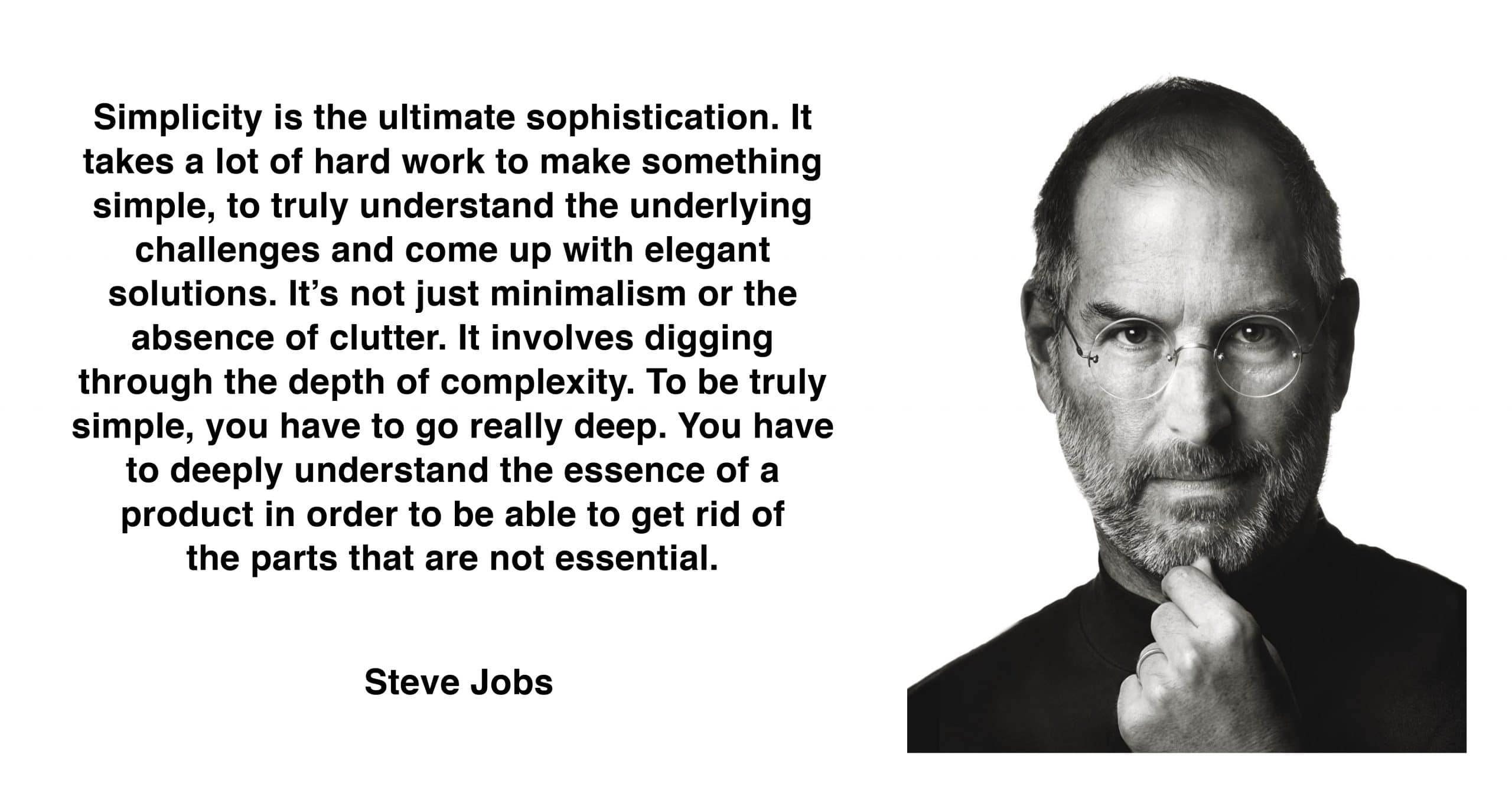
Undoubtedly, simplicity is one of the values Steve Jobs held very close to his heart. For example, he built simplicity into everything Apple did and everything it stood for. Even over the last decade, Apple is still following the Steve Jobs playbook.
Apple Brand Positioning - how they use 'simplicity'
The apple brand positioning builds everything behind the “simplicity” brand idea..
We use our consumer benefit ladder to find differentiation. Importantly, turn your brand’s features into consumer benefits. Stop thinking about what your brand does. And, start thinking about what your consumer gets. That’s when the Apple brand positioning statement comes alive.
Functional consumer benefits.
To help brand leaders kickstart their brand positioning work, I have created 12 functional zones that expand to over 50 potential functional benefits. For instance, as you look through the list, gravitate to the functional benefits you think will fit your consumers’ needs and differentiate your brand by looking for words where your brand does it better than competitors. While you might start with our words, try to layer in your own creative language with the specific category or consumer language.
Emotional consumer benefits.
Below is a list of 40 potential emotional benefits that help build an emotional brand positioning statement that differentiates your brand. Importantly, you want to own one emotional space in the consumer’s heart as much as you own the rational space in the consumer’s mind.
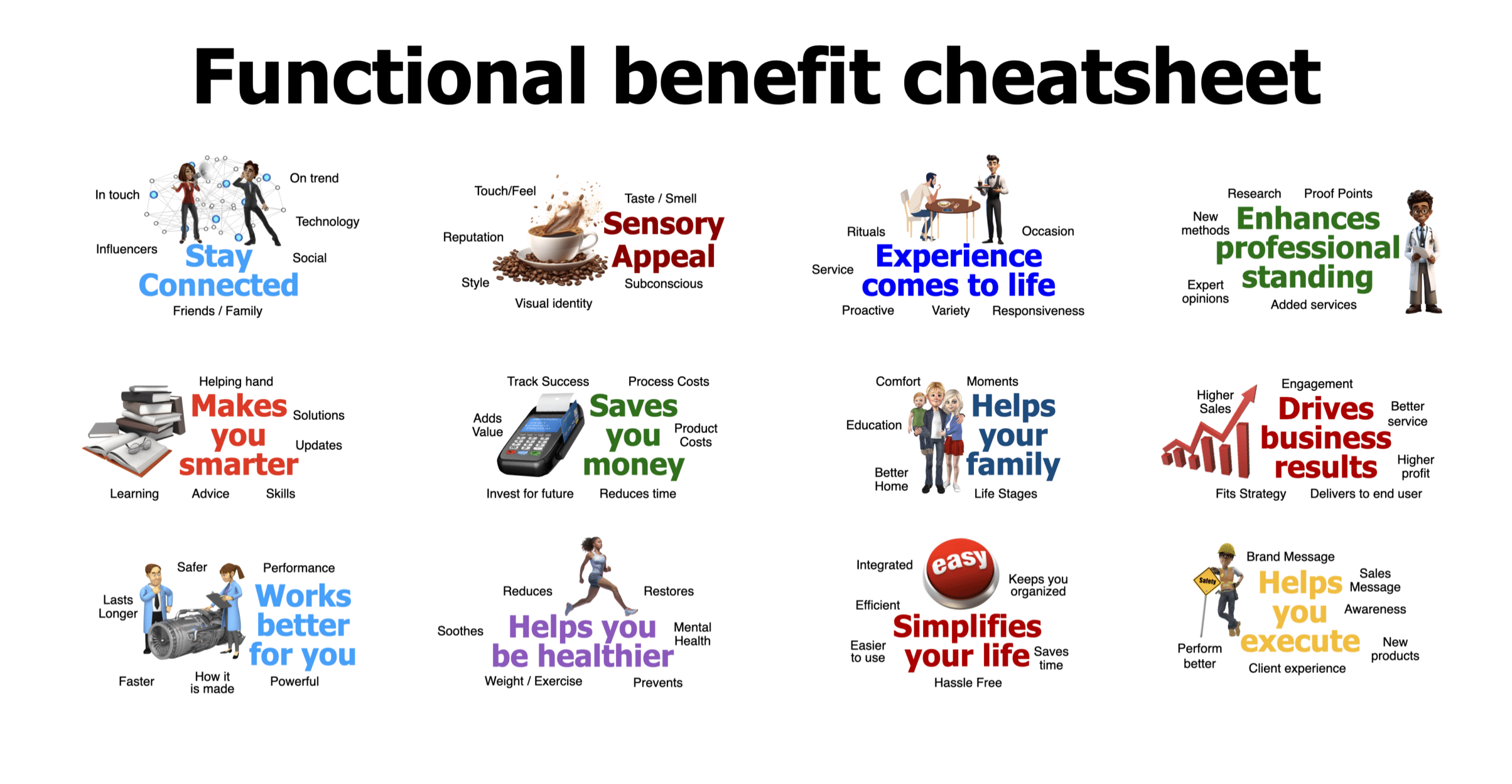
To illustrate, click on our Consumer Benefit Cheatsheet to build the Apple brand positioning .
Choosing the right benefit clusters for Apple
Using our brand positioning process, the Apple brand positioning narrows in on the brand’s potential benefit clusters of the functional and emotional benefits.
What Apple does: best features
- Intuitive and easy to use: Apple allows everyone to do more and get more from their devices.
- Stylish designs: Fashion-forward designed so that people want to show them off.
- Integrated technology: All devices, software, and services work harmoniously, enhancing user experience.
- Fresh innovation: Apple customers always have access to cutting-edge features and advancements.
What Apple consumers get: functional benefits
- Simplifies your life: Hassle free, easier to use, integrated.
- Sensory Appeal: Touch/feel, subconscious, and style.
- Experience: Responsiveness, rituals, and service.
How Apple consumers feel: emotional benefits
- Feel free: Alive, excited, exhilarating.
- Get noticed: Cool, trendy, popular, and playful.
- Optimism: Successful, inspired, and motivated.

To illustrate, click on our Consumer Benefit ladder we use to build the Apple brand positioning .

Apple Brand positioning statement
Once everything is settled, the overall Apple brand positioning statement focuses on simplifying technology to help you feel smarter so you can do more with every device.
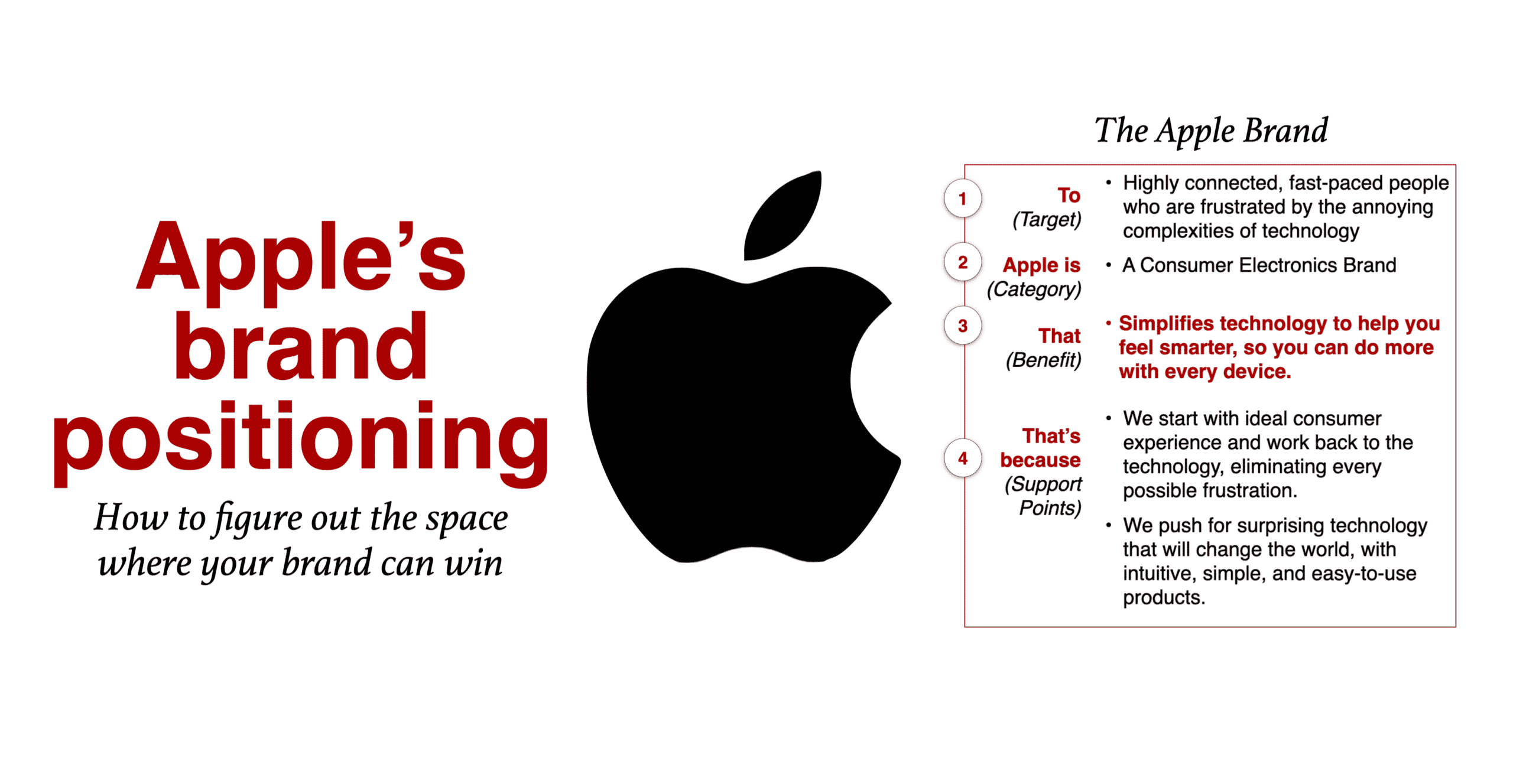
To illustrate, click on the Apple Brand Positioning Statement . You can zoom in, download it, or share it.
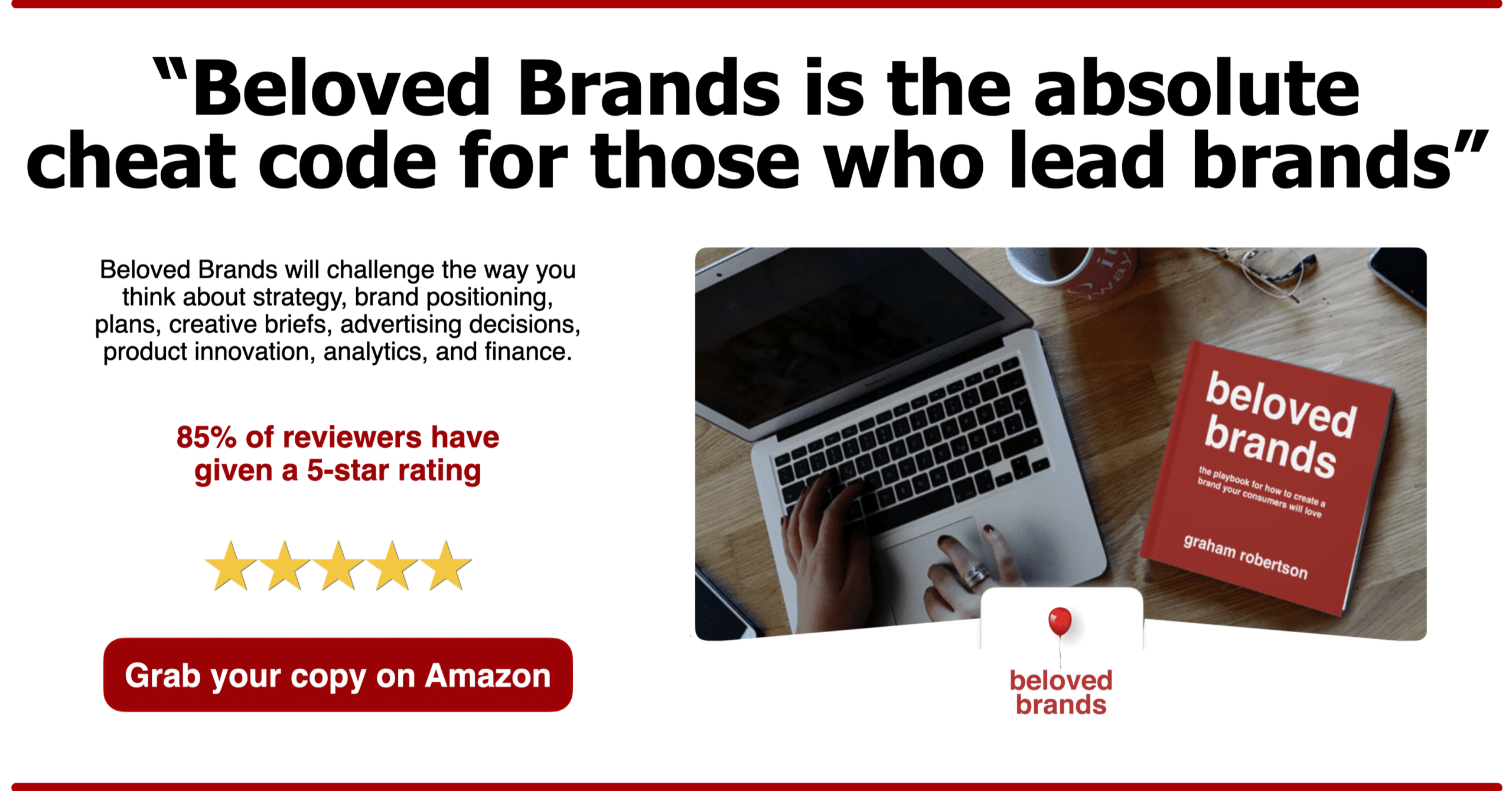
Old school brand positioning vs new school
When brand positioning began in the 1970s and 80s, the goal was to stay single-minded and focused and even get down to one word. For example, Volvo was about SAFETY. I still believe in that thinking for marketing communications. If all Volvo does is “safety,” no one would pay $50,000 to $70,000 USD for their cars. The additional benefits earn extra money for the comfortable leather seats, stylish design, and high-quality radio.
However, as brands have matured, the brand positioning should drive product innovation, the purchase moment, and the ideal consumer experience. One word might not be enough. Now, we can see brands can own a cluster of benefits.
Below, we can see the cluster of benefits, both functional and emotional, to create a word cloud for Apple. These words can show up as support communications to the ‘simplicity’ idea. Moreover, these words should appear in product design, in-store layout, people management, and consumer experience. These words should drive every part of the Apple brand strategy.
In a similar vein, the pharmaceutical industry has also adapted its marketing strategies to meet the changing demands and expectations of consumers. Take, for example, Motilium, a medication used to treat nausea and vomiting. As brand positioning evolves, the marketing for Motilium not only highlights its effectiveness but also emphasizes convenience and accessibility by promoting the option to buy Motilium online ( reference ). This adaptation ensures that the messaging is not just about the functional benefit of symptom relief but also about making the purchase process as easy as possible for the consumer, aligning with modern expectations of convenience and immediate availability.

To illustrate, click on our Cluster of Consumer Benefits that we use to build the Apple brand positioning .
Make your marketing people smarter with our Beloved Brands Marketing Training
We focus on essential Marketing Skills so your brand managers will be stronger at brand analytics, strategic thinking, brand positioning, brand plans, and marketing execution. I bring my experience as a past VP of Marketing, with experience at every level of marketing while at Johnson & Johnson, Coke, and General Mills. I teach how the best marketers are expected to show up. As a result, your team will thrive in today’s marketing world, produce better work, and drive stronger results for their brand.
To view, use the arrow to see our Beloved Brands Marketing Training program video.
Building Apple's brand idea
Everyone seems to call the short-form description of a brand by different names; brand DNA, big idea, brand essence or shout from the mountain. I keep it simple by calling it the brand idea. To win in the marketplace, your brand idea must be interesting, simple, unique, inspiring, motivating, and ownable.
I created a brand idea blueprint with five ideas that surround it.
On the internal brand soul side, describe the products and services and the cultural inspiration, which is the internal rallying cry to everyone who works on the brand. On the external brand reputation side, define the ideal consumer reputation and the reputation among necessary influencers or partners. The brand role acts as a bridge between the internal and external sides.
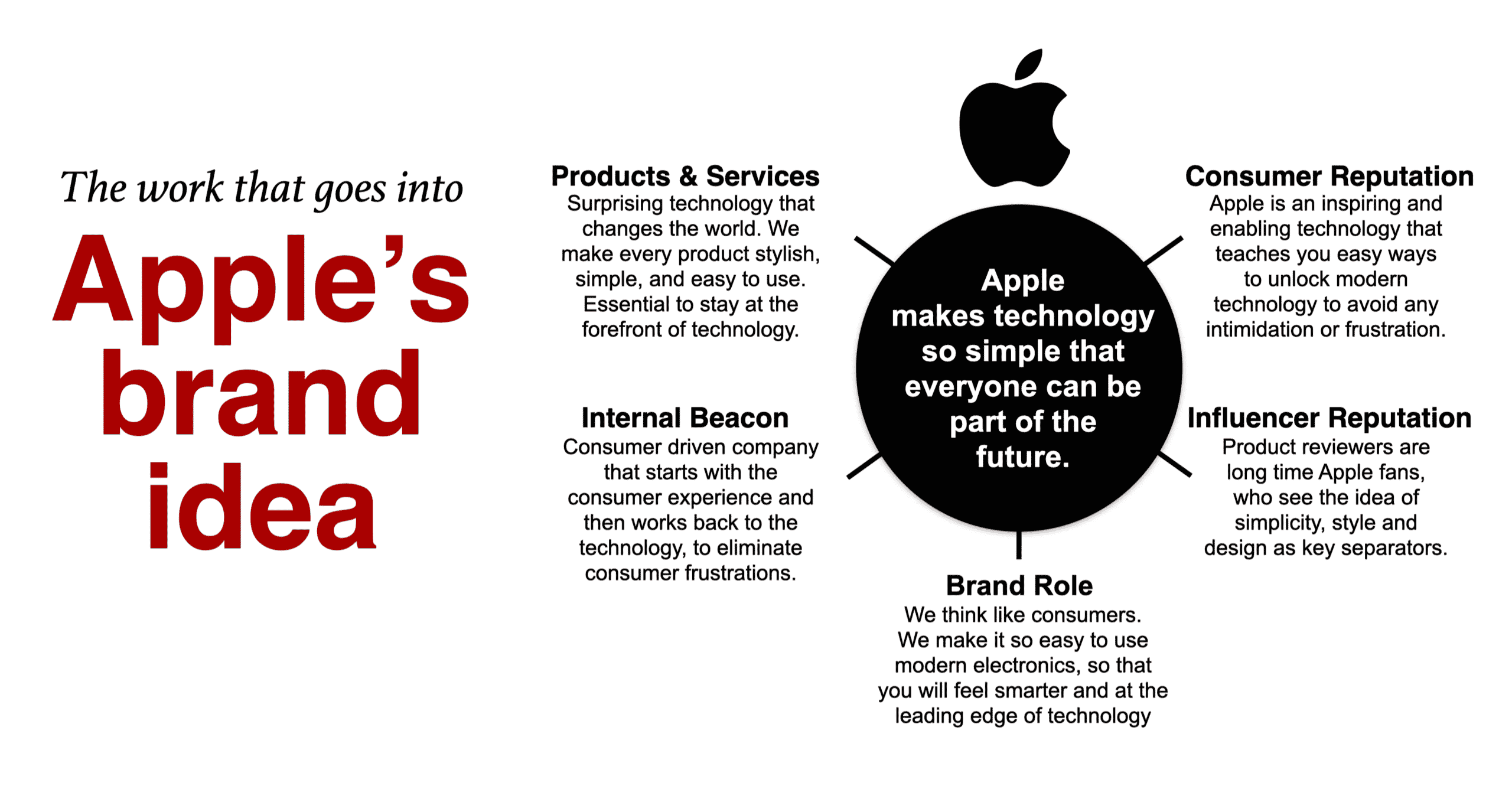
To illustrate, click on the Apple Brand Idea we use to build upon the Apple brand positioning .
The Apple case study uses the brand idea for Apple is “making technology so simple that everyone can be part of the future.” Most importantly, Steve Jobs insisted they take a consumer-first mentality as they transformed leading technology advancements into “consumer-accessible” technology, helping fuel the perception among the mass audience that Apple is an innovative leader.

To illustrate, click on the Apple Brand Idea Map we use to build upon the Apple brand positioning .
Apple Case Study - video
Our apple case study is part of our beloved brands mini mba. take a look..
Below is an example video (30 minutes) from our Beloved Brands Mini MBA. We use the Apple case study to demonstrate the Apple brand positioning tools.
To view the Beloved Brands Mini MBA video , use the ▶️ button to play.
Apple's Brand Key Model
A Brand Key model is a tool from consumer marketing that allows marketers to lay out their brand’s unique selling proposition (USP) elements on one page. This article will go through the Brand Key model with nine elements that build the USP. And, with each element, we will show you the work you need to do.
Below is the Brand Key example for the Apple brand. It brings to life Apple’s unique selling proposition of simplicity. To read more on brand key models, click this link: Using a Brand Key Model to Define your Brand’s USP.

To illustrate, click on the Apple Brand Key we use to express the Apple brand positioning .
Take a look at our best posts
Click on any story below to read the more.
Use Apple's brand idea as a lens to see the problems not delivering
Apple has done a great job taking that simple brand idea and stretching it across its brand story through advertising and its innovation plan (as they have entered many new technology categories).
They have also used their brand idea to guide how they manage the purchase moment (to make sure their retail outlets are easy for consumers) and how they create happy experiences. And, when they don’t nail the ideal consumer experience, they go out of their way to help. They also have the genius bar and on-site lessons, which help increase consumers’ knowledge.
The other beauty of having a crystal clear brand idea is that everything that goes against that brand idea almost acts like an obvious virus. Below are four examples of where Apple is missing out on “simplicity,” which puts the brand idea at risk. Above all, these should trigger action plans to build into your brand plan. In pointing out these flaws within our Apple case study, I am yet to see Apple take action.
I wonder what Steve Jobs would think of these flaws.
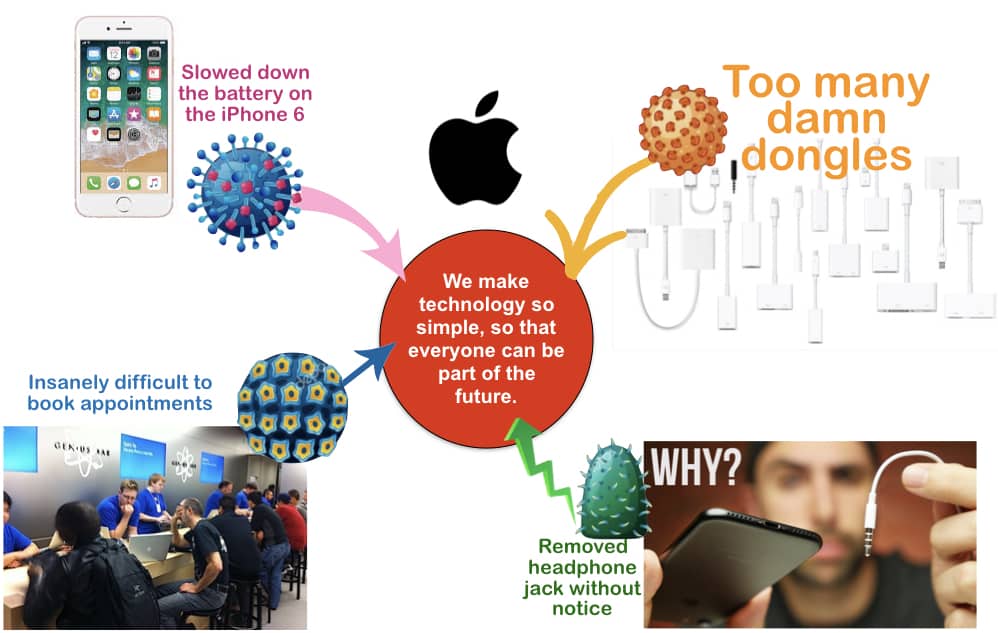
To illustrate, click on the Apple Case Study diagram to show where they go aga inst the Apple brand positioning.
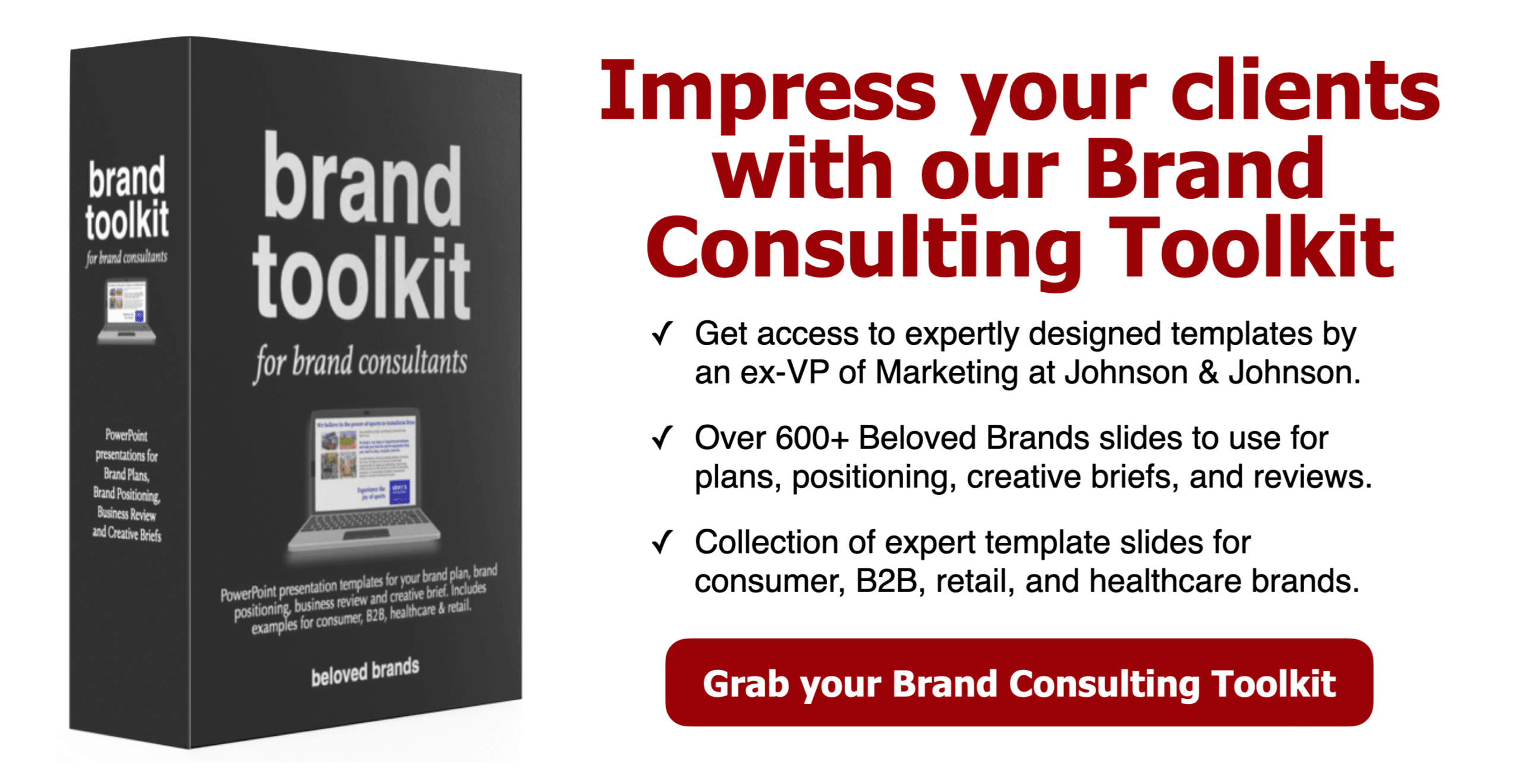
Apple brand strategy
How the five elements of smart strategic thinking sets up apple's famous turnaround plan:, 1. set a vision of what you want..
To start our Apple case study, their vision is to make it easy for everyone to be part of technology in the future. The main issue was creating brand fans and then mobilizing them to spread the word to the masses.
2. Invest resources in a strategic program.
Next, Apple invested and aligned everything behind the Apple brand positioning and brand idea: “Apple makes technology so simple; everyone can be part of the future.” They use this brand idea at every touchpoint, including the brand positioning, communication, innovation, purchase moment, and experience.
3. Focus on an identified opportunity.
For decades, Apple consistently focused on empathizing with—and taking advantage of—the consumer’s frustration with technology. In the 1980s, they attacked IBM’s personal computers as too complicated. In 2005, they used “I’m a Mac, and I’m a PC” advertising to attack Microsoft. Each time, it used its “consumer-first” mentality to transform leading-edge technology into accessible consumer technology.
4. Leverage a breakthrough market impact.
Above all, the Apple brand strategy takes a fast-follower stance that takes current technology and makes it simple to use. Every platform, including desktops, laptops, phones, watches, tablets, and music streaming, delivers the brand idea of simplicity. They deploy high-profile launch hype to use vocal advocates to spread the word to their friends.
5. Performance result that pays back.
Most importantly, Apple created a consumer bond with its brand fans to enter new categories. On top of that, it is now the most beloved consumer-driven brand, with premium prices, stronger market share, sales, and profits. The Apple brand strategy used brand love to help drive a remarkable 40x revenue growth over ten years, skyrocketing from $5.7 billion in 2005 to $240 billion in 2015. This rapid growth helps cover the high costs of advertising and R&D, giving them very healthy operating margins, up over 35%. All this strategic effort has increased their market capitalization by over $1 trillion.
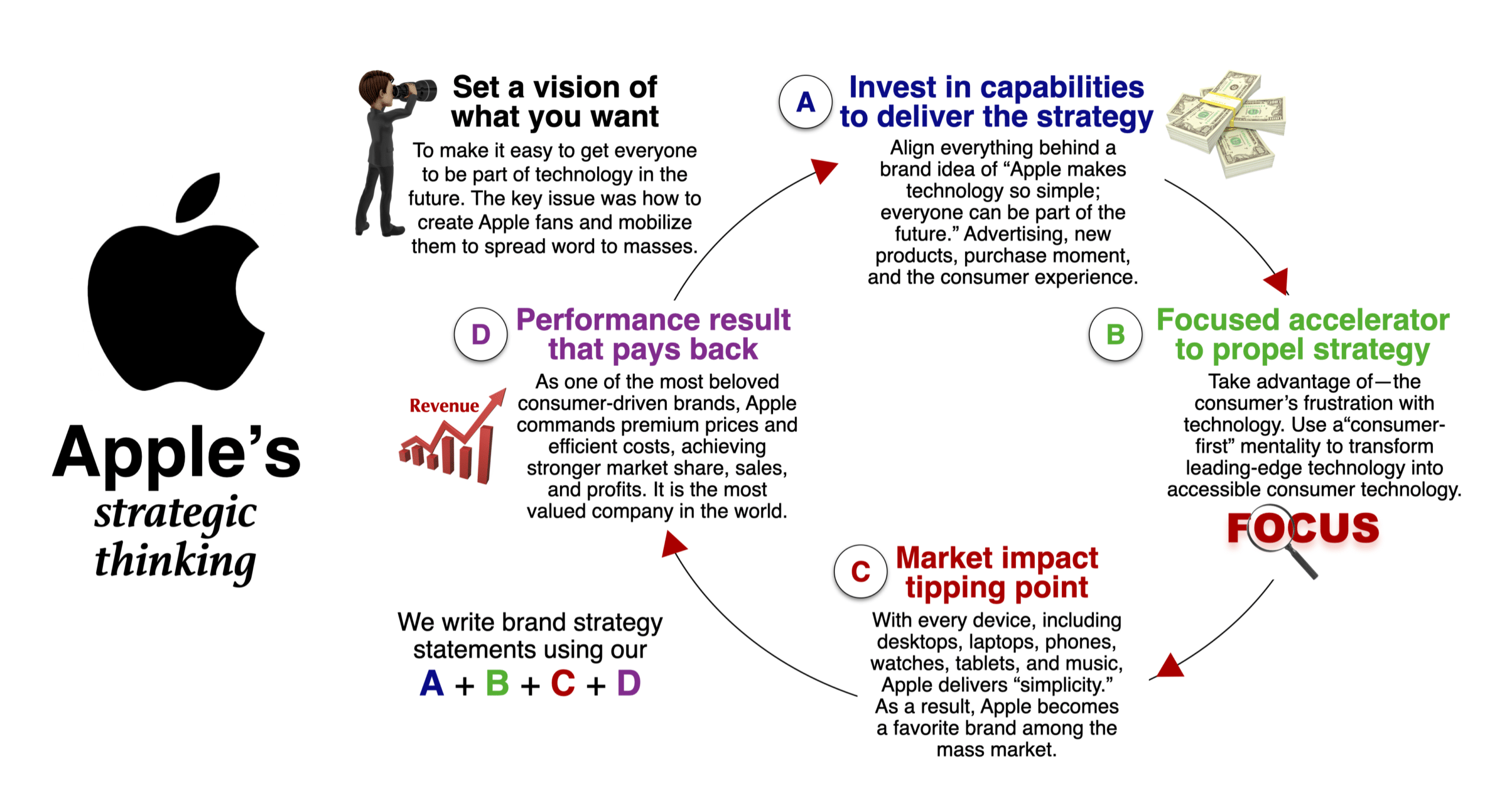
To illustrate, click on the Apple Brand Strategy diagram . You can zoom in, download it, or share it.
Apple brand plan
We are going to build out a Brand Strategy Roadmap that can steer the brand for the next three to five years. And, we’ll show a one-page Annual Brand Plan. We’ll show the rough brand plan work you can do.
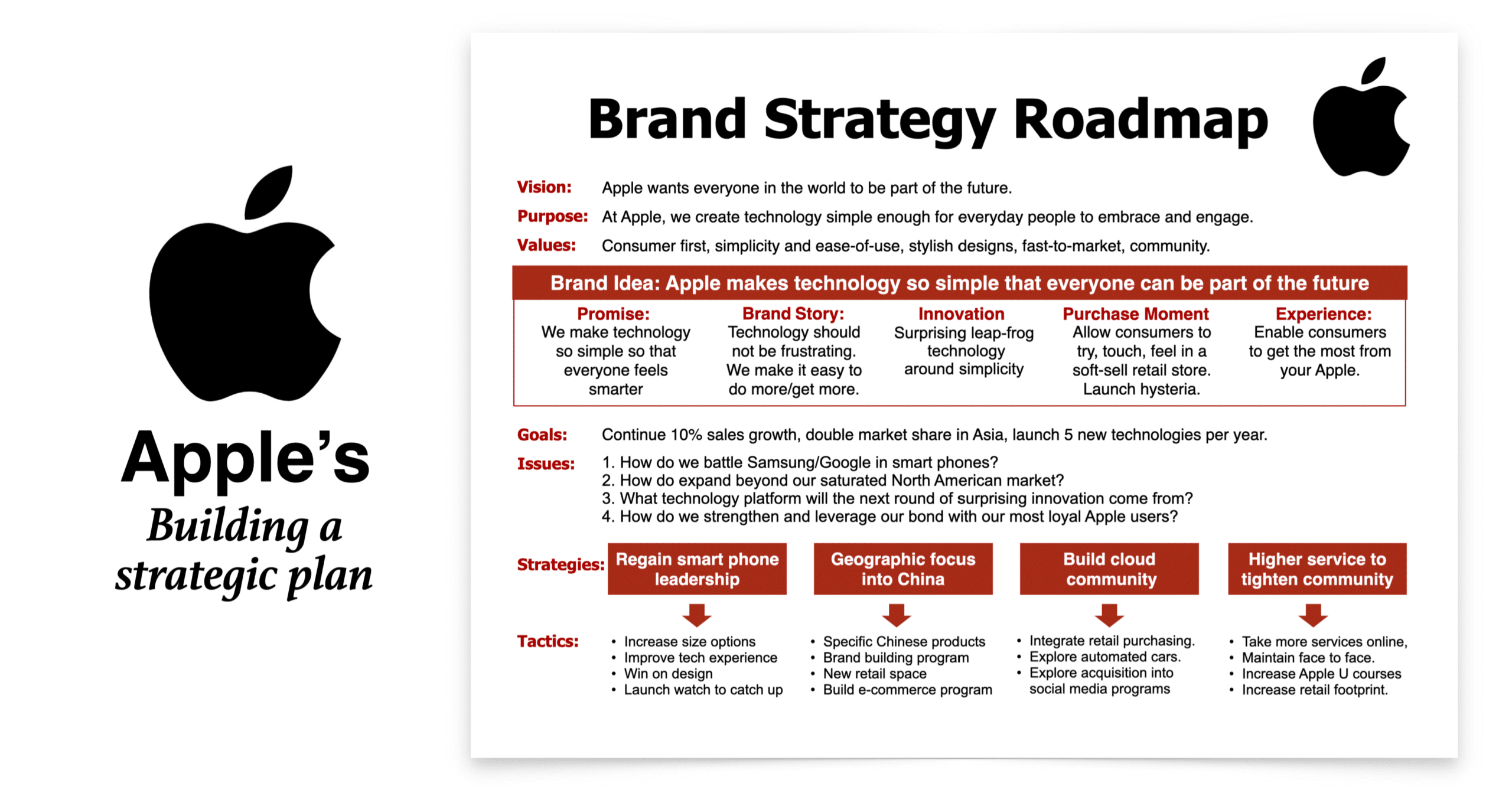
To illustrate, click on the Apple Brand Strategy Roadmap . You can zoom in, download it, or share it.
The rough brand plan for Apple
With the Apple case study, our strategic thinking model sets up the core elements of the Apple brand strategy:
Apple wants everyone in the world to be part of the future.
Continue aggressive sales growth, geographic expansion into China, and launch a major new consumer-friendly technology each year.
Key issues:
- How do we convey Mac’s superior user experience versus the traditional PC?
- How do we enter the music industry and increase the availability of online music to support our iPod?
Strategies:
- Apple will launch a full communications assault to challenge the PC/Microsoft Windows dominant position by finding flaws in the PC to contrast with Mac computers’ simplicity to steal significant market share by enticing frustrated PC consumers to buy a Mac.
- Apple will launch a full assault against the entire music industry with a disruptive innovator stance to show how iTunes provides higher quality digital music on your iPod much cheaper, faster, and smarter than CDs to gain an entry point into the music industry.
- TV advertising to highlight new features and challenge competitors.
- Launch innovation each year, including phones, tablets, online music, watches, and personal computers.
- Launch specific products for China. Increase retail space around the world. Build out the e-commerce program.

To illustrate, click on the Apple Brand Plan example that brings the Apple brand positioning to life.
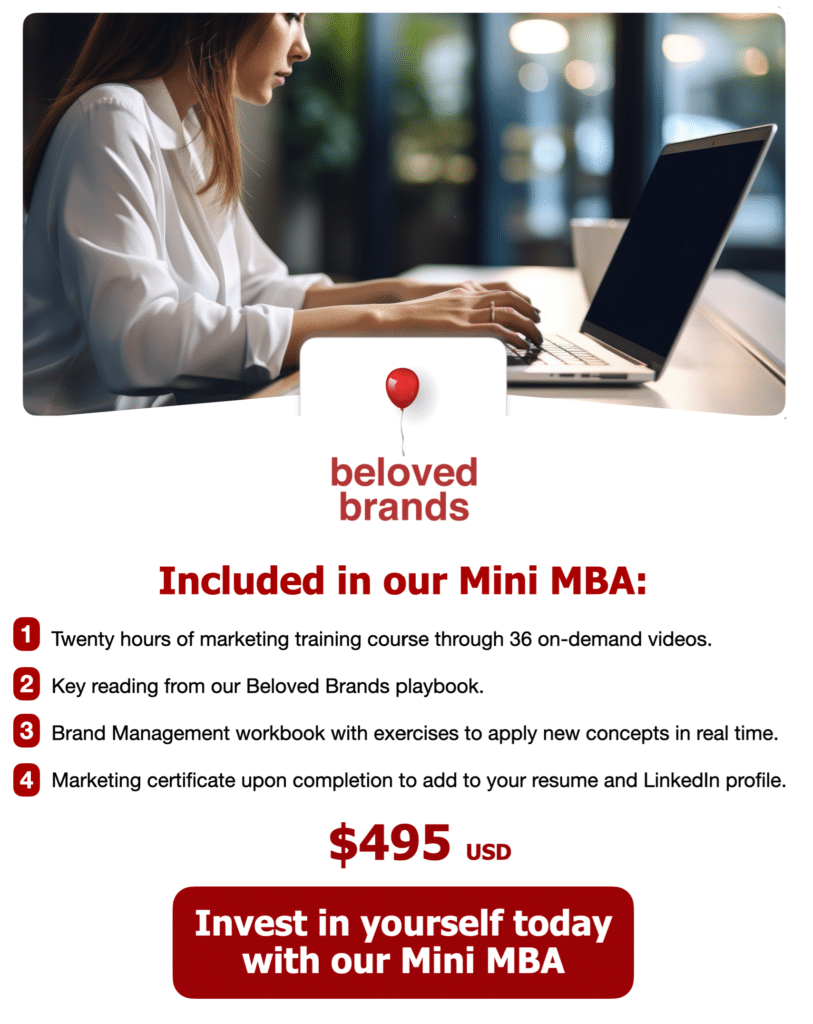
Apple advertising
Advertising has delivered “simplicity” since the 1970s.
Apple’s advertising has been relatively consistent for over 40 years and incredibly connected with consumers. As Steve Jobs was launching Apple, the early print ads of the 1970s talked about how we designed the computer, so you don’t have to worry about the details.
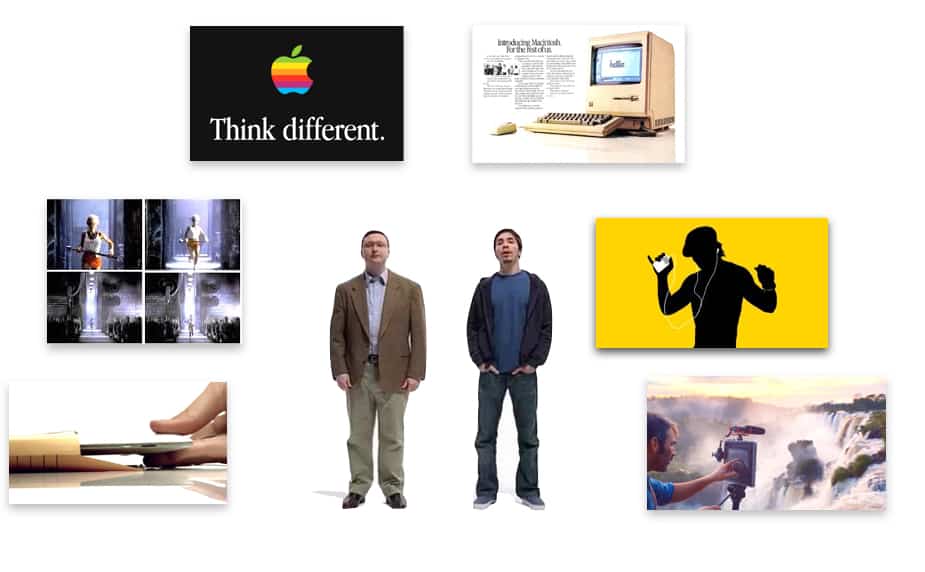
Steve Jobs pushed for the “1984” TV ad for the Mackintosh launch that spoke about freedom from machines. Although the message was a little ahead of its time, it fit with simplicity. Above all, the brilliance of the side-by-side “I’m a Mac, and I’m a PC” TV ads epitomized the brand idea by making the PC seem overly complicated and frustrating while setting up the Mac as the simple alternative. These ads really express the Apple brand positioning statement.
Take a look at some of "I'm a Mac" TV ads. Enjoy!
To illustrate, click the ▶️ button to see the Apple brand advertising that brings the Apple brand positioning to life .
Apple innovation
Building product innovation around simplicity.
Apple has taken many failed technology ideas like online music, tablets, or mp3 players and turned them into consumer-friendly platforms such as iTunes, iPads, and iPods. With each new product, Apple uses launch hype to generate excitement to spark the enthusiasm of the early adopters who spread the word. Also, Apple has successfully taken its cherished brand fans into new categories.
The combination of Johnny Ives and Steve Jobs created many great Apple products.
Learn how to make innovation decisions.

Video on Apple's product innovation philosophy
To view the Apple brand innovation philosophy, use the ▶️ button to play.
Apple retail
Purchasing apple products is very simple, including its own retail store experience.
Retail stores are a significant part of the Apple Case Study.
Steve Jobs saw a vision for retail to help Apple use simplicity to manage the purchase moment through its retail stores, ensuring the experience is simple and straightforward. All staff carry a credit card machine and complete the transaction very quickly. No lines or cash registers.
Simplicity shines through the store layout, with the genius bar for one-on-one tech questions and support and the training area to teach classes. The brand also displays every Apple product to allow consumers to take them for a test drive. It’s all about delivering the consumer experience that Steve Jobs loved so much.
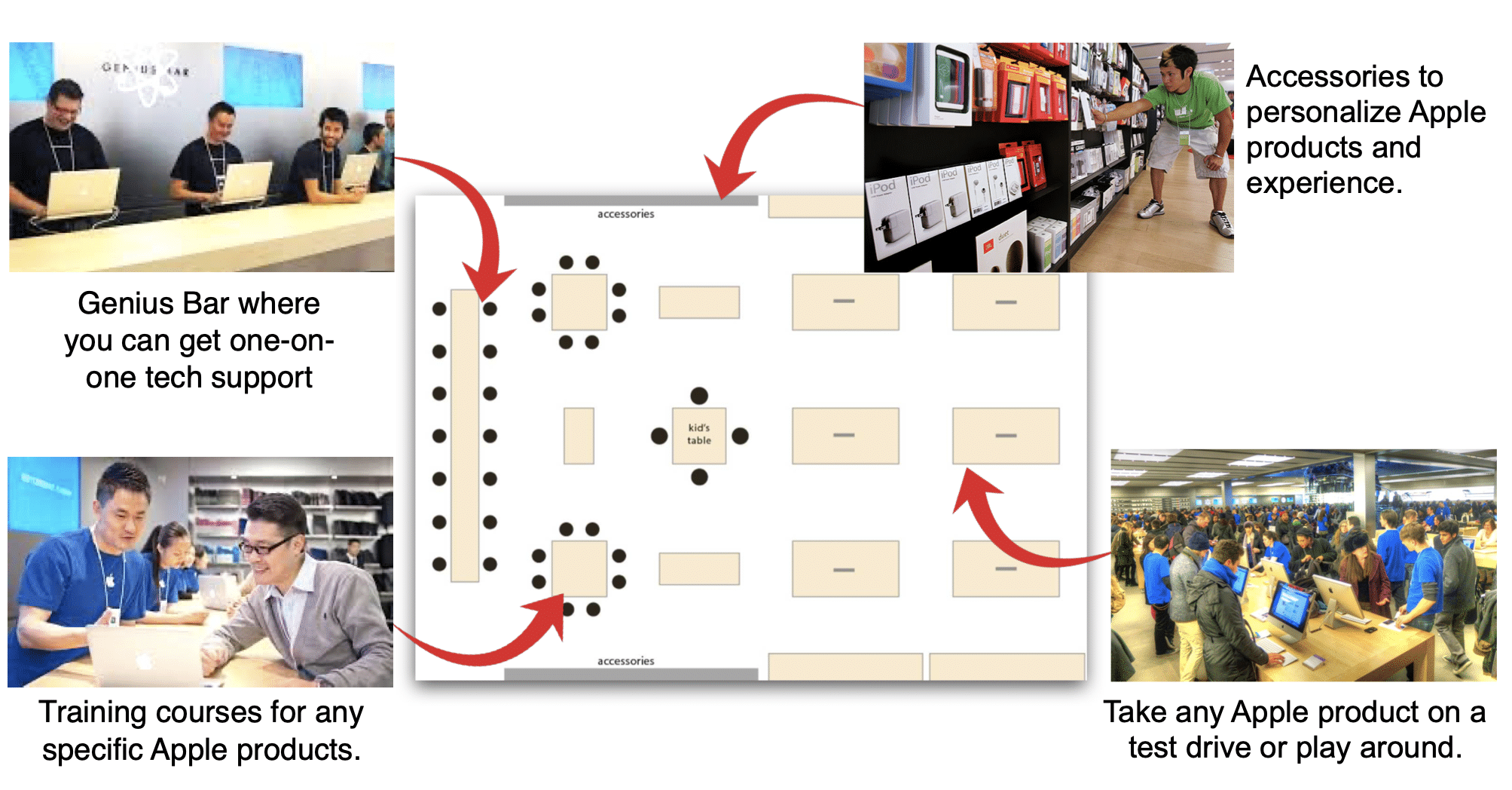
To illustrate, click on the Apple Store Layout. You can zoom in, download it, or share it.
Even when Apple products are in other stores, the brand has used its power with that retailer to create a distinct store-within-a-store concept, replicating a similar look and experience from Apple’s retail locations.
Fifth Avenue Apple store in NYC

Tower Theater Apple store in LA

To illustrate, click on the Apple Store examples. You can zoom in, download it, or share it.
Apple in Singapore
Milan Apple store
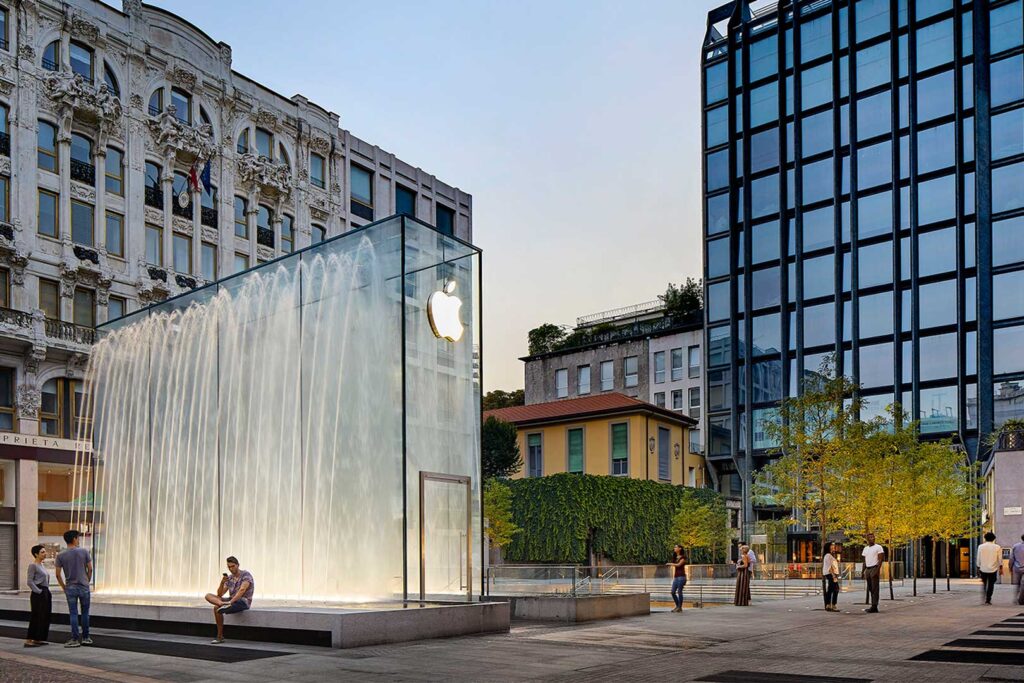
Apple consumer experience
Obsessing about the consumer experience.
As Steve Jobs famously said, “You have to start with the customer experience and work backward to the technology.” Apple even believes opening your Apple products should be like unwrapping a gift.
Steve Jobs wanted the consumer to be able to use any Apple product right away rather than spending hours loading software or setting up their machine. Regarding product integration, Apple products work together, and they work the same way, which makes it very simple for consumers when they move from one Apple product to another.
Next time you are in a brainstorming session, try to think like Steve Jobs.

To illustrate, click on the Apple Consumer Experience. You can zoom in, download it, or share it.
The power of the Apple brand - how loyalty drives profit
How apple's brand love leads to increased power.
As we continue our Apple case study, let’s look at the power and profit Apple generates through brand love.
As they achieved an extremely tight bond with loyal followers, they used the tight consumer bond to generate brand power that they quietly wield in the market. Apple’s retail network generates twice the sales per square foot of any retailer worldwide, yet it is a very soft-sell environment.
I was recently on a double-decker bus tour of New York City, and when the bus went past the 5th Avenue Apple flagship store, half the bus stood up to take a photo. And they have such power over the supplier network with an array of engineers following extremely tight procedures.
Also, they have power over the media, generating over $2 billion worth of free media each year. Moreover, Apple fans often want to work at Apple, giving up lucrative jobs to be part of the brand.
Smartphone loyalty scores
Below, we can see the loyalty scores of the various smartphones. Apple leads the way with over 90% loyalty, moving from one model to the next. Samsung’s loyalty is below 70%. And LG has fallen to 32%. At LG’s level, you constantly need to source new consumers. That’s an extremely expensive way to manage your brand.

To illustrate, click on the Apple Case Study diagram . You can zoom in, download it, or share it.
Whoever says loyalty does not exist has not talked with Apple consumers. Apple significantly outperforms its competitors and uses that loyalty to drive future sales.
Apple's prices continue to increase
As Apple’s loyalty holds strong, they can increase their prices with each model. Loyal consumers are less price sensitive. This translates the Apple brand strategy into added profits. Steve Jobs used hype marketing to create a very tight bond with consumers.
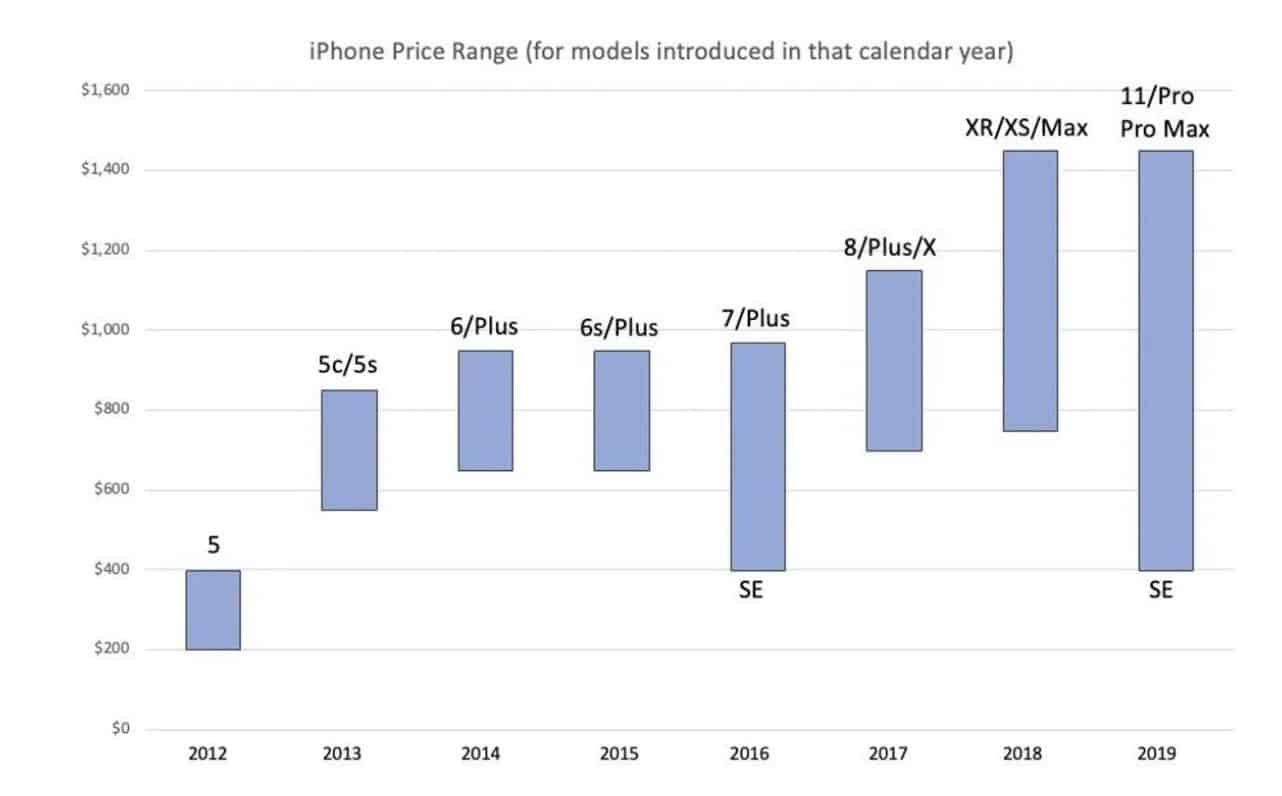
To illustrate, click on the Apple Case Study diagram. You can zoom in, download it, or share it.
We can see how Apple uses power over its consumers to increase prices each year. Their iPhones deliver 40% profit margins, 4x higher than their competitor’s profits.
How Apple's brand power leads to increased profit
The Apple brand strategy extrapolates the power they generate into profit , with their incredible financial performance over the last 15 years. And they generate significant price premiums, relatively lower cost of goods, and moderate marketing spend ratios. Most importantly, this keeps their margins healthy for a technology firm.
Furthermore, Apple has entered many new categories over the past 15 years. Each time, their army of loyal fans has followed, moving into laptops, phones, tablets, and the music business. In each segment, they continue to gain market share to drive volumes.
Finally, the higher margins and volumes make for a beautiful profit statement.
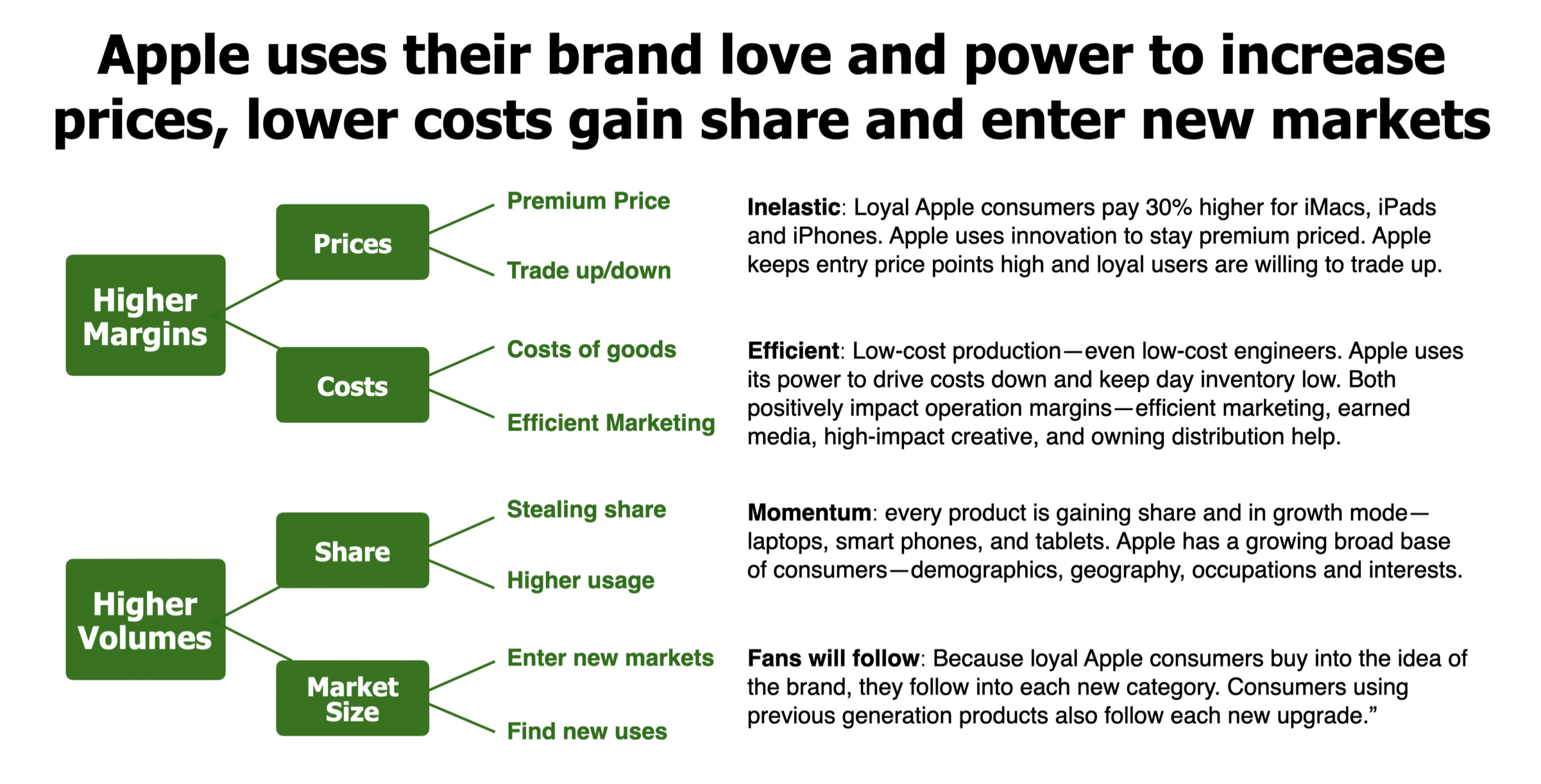
We can use our eight ways that a brand can drive profit to see the impact of the magic of the Apple brand on profits. Apple uses price, cost control, entry into new categories, and driving market share in each category.
Even though Apple gives the perception of an extremely friendly brand that is on the side of the consumer, they are now a huge mass market corporate brand, with a market capitalization of $500-600 billion, which is 2-3 times the value of companies like Coke, Procter & Gamble, Pfizer, and IBM.
So, if you invested a mere $10,000 in 2005, you would have $240,000 a decade later. The Apple case study is indeed a glorious look at the vision of Steve Jobs.
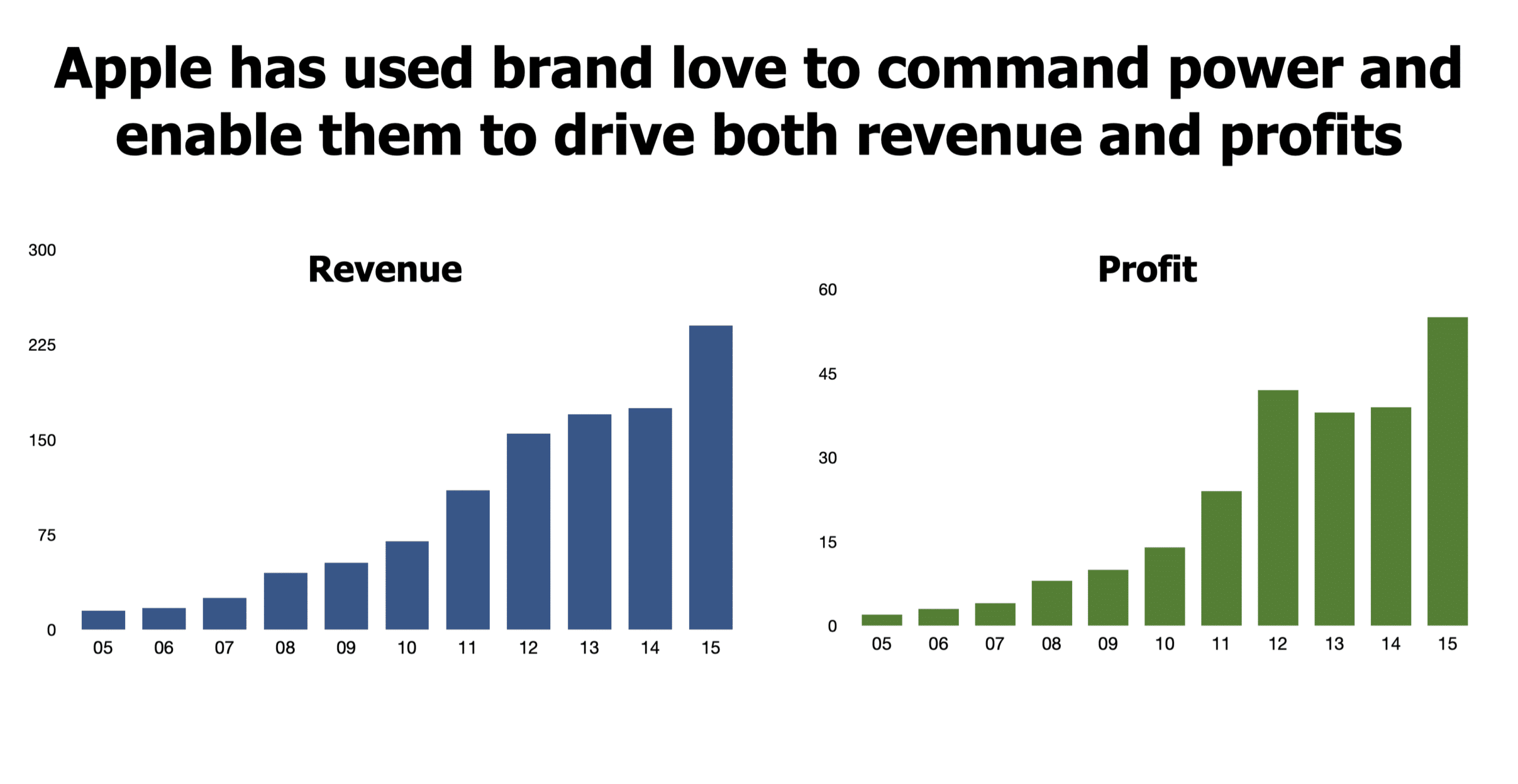
To conclude our case study, we can see how Apple uses its brand strategy to drive loyalty, revenue, and profitability each year. Their P&L is a thing of beauty.
Apple turns their brand love into higher power and profits

Contact Information
Graham Robertson
Email: [email protected]
Phone: 416–885–3911
Search our site for any marketing topic
M a r k e t i n g B o o k
beloved brands
The playbook for how to create a brand your consumers will love.

With our Beloved Brands playbook , you will learn to think strategically, define your brand positioning, write a marketing plan, make execution decisions, and analyze your brand. Our readers tell us they reach for Beloved Brands as a reference tool to help them with the day-to-day management of their brand. We are proud that 89% of online reviewers have rated Beloved Brands a 5-star. As a result, Beloved Brands has been a #1 bestseller in brand management. We also have the B2B Brands playbook and our Healthcare Brands playbook .
Marketing Training
The smarter your team, the better the results you will see!
As a marketing team leader, you know that your team’s success is essential for your company’s growth. Our Beloved Brands marketing training gives your team the skills they need to make strategic decisions, produce exceptional work, and drive business growth. They will learn to define brand positioning, write effective plans, improve brief writing, make informed execution decisions, and analyze their brand’s performance.

We have designed our marketing training program to build the fundamental skills to help your team reach their full potential. We will work with your team to help them learn to take on Strategic Thinking, Brand Positioning, Marketing Planning, Marketing Execution, and Brand Analytics.

Popular Posts
Brand Positioning
Marketing Plans
Brand Strategy Roadmap
Creative Briefs
Marketing Career
Brand Key Model
Brand Toolkit
Brand Toolkit for B2B
Brand Toolkit for Healthcare
Marketing Plan Template
Brand Plan template
Positioning template
Brand Consulting
Beloved Brands
Healthcare Brands
416 885 3911
.png)
Case Studies for Product Management: A Deep Dive
We can all agree that applying real-world product management strategies is crucial for success.
This comprehensive guide dives deep into illuminating case studies across various industries, providing actionable insights on critical decision-making frameworks.
Introduction to Product Management Case Studies
Product management involves overseeing a product from conception to production to ensure it meets customer needs. Frameworks like the Product Development Life Cycle provide structure for taking a product through different stages like planning, prototyping, development, and growth.
Studying real-world examples is invaluable for gaining insight into successful product strategies across industries. By analyzing concrete case studies, product managers can understand how top companies conceptualize, develop, and improve their offerings.
Defining Product Management and its Frameworks
The role of a product manager is to understand customer needs and guide development of solutions. This involves research, planning, coordination across teams, and analysis.
Some key frameworks provide processes for product managers:
- Product Development Life Cycle - Conceptualization, Development, Growth, Maturity Decline
- Jobs To Be Done - Focusing on the job the customer aims to get done
- Design Thinking - Empathizing, Defining, Ideating, Prototyping, Testing
These frameworks help structure product decisions and strategy.
Importance of Best Case Studies for Product Management
Analyzing detailed examples of product management in action provides:
- Real-world demonstrations of frameworks
- Examples of product development decisions
- Insights into product successes and failures
- Strategies across industries and product types
By studying case studies, product managers can learn best practices to apply in their own work.
Overview of Industries and Product Case Study Examples
Upcoming sections will explore product management case studies from:
- Technology - Software, hardware, apps
- Retail & ecommerce - Online and brick-and-mortar stores
- Financial services - Banks, investment platforms
- Healthcare - Electronic medical records, patient apps
Specific companies like Apple, Nike, Intuit, Kaiser Permanente will be used to demonstrate product decisions.
What are case studies for Product management?
Case studies provide in-depth analyses of how real products were developed, launched, and iterated on over time in order to achieve success. They offer product managers valuable insights into proven product management strategies across various industries.
By examining case studies, product managers can learn how top companies approached critical activities like:
- Conducting market research
- Defining product requirements based on user needs
- Prioritizing features and functionality
- Developing prototypes and minimum viable products (MVPs)
- Designing effective user experiences
- Iterating based on user feedback
- Tracking key metrics and optimizing
- Developing go-to-market strategies
- Scaling successfully
Additionally, case studies allow readers to understand the reasoning behind key decisions, including both successes and failures. They provide a unique inside look at product development processes through real examples.
Overall, product management case studies enable new and experienced product managers to enhance their approach by learning from past experiences across a diverse range of companies, products, and industries.
How to make structure in case studies for Product management?
Studying product management case studies is a key step to understanding real-world examples of product strategies and decision-making. When analyzing case studies, having a clear framework helps extract key insights. Here are four steps to structure your analysis:
Evaluate the Need
- What customer problem does the product solve?
- How was the need validated through research?
- What metrics indicate the market size and demand?
Validate the Solution
- How does the product solution address the key pain points?
- Were experiments and prototypes done to validate assumptions?
- What early traction or usage metrics demonstrate solution fit?
Set Goals and KPIs
- What key goals and objectives guide the product roadmap?
- How do key performance indicators track progress towards goals?
- What metrics align to the customer and business goals?
Evaluate Decisions and Outcomes
- What key decisions shaped the product strategy and features?
- How did experiments and iterations impact the product direction?
- What final business and customer results were achieved?
Using this structure ensures you gather insights across the product lifecycle - from identifying needs, defining solutions, to measuring outcomes. Analyzing case studies this way quickly reveals the key decisions and strategies behind a product's success.
What are the 4 types of case study?
Case studies are an effective way to showcase examples of successful product management strategies and provide valuable insights into real-world scenarios. There are four main types of case studies:
Illustrative Case Studies
These provide a descriptive overview of a product, business, or industry. They tell the story of a product's development, struggles and successes. Illustrative case studies help set the scene and provide context.
Exploratory Case Studies
Also known as pilot case studies, these are condensed case studies performed before implementing a large scale investigation. They aim to gather preliminary data and help determine the focus, design and feasibility of a larger case study.
Cumulative Case Studies
These aggregate quantitative information from several sites or sources. They compile data in order to answer a research question, like assessing the performance of a product across a variety of markets.
Critical Instance Case Studies
These examine a single instance of intense interest. They provide valuable insights from a business success or failure. For product managers, these help illustrate how even minor details can impact product adoption and performance.
How to prepare for case study interview for product manager?
Preparing for a case study interview as a product manager candidate requires focused preparation across four key areas:
Understanding the Case Study
- Research the company, product, industry, and business context thoroughly to identify potential issues and scenarios the case study may present.
- Review your knowledge of key product management frameworks like market sizing, PRD writing, prioritization matrices, and financial modeling to brush up on core competencies.
Knowing the Interviewers
- Understand the background and seniority level of the interviewers. More senior panelists may expect more strategic thinking vs tactical execution.
- Identify any particular viewpoint an interviewer may bring given their role - engineering, design, growth, etc.
Setting Assumptions
- Clarify any assumptions you can make about the case details upfront instead of getting derailed later.
- Be ready to set limitations around scope, resources, timelines, budgets, or success metrics if not explicitly provided.
Applying Strategy
- Use an open-ended, discovery-based approach for broad business challenges without an obvious solution path.
- Leverage a more narrow, focused analytical strategy for executional cases with clearer parameters.
Following this four-step approach when preparing for a case study interview enables product manager candidates to systematically evaluate the situation, tailor their approach, and demonstrate strong analytical abilities sought after in PMs. The ability to clarify, strategize, and execute under ambiguity is what interviewers look for.
Product Development Case Studies
This section features examples of innovative and user-focused product development processes that led to successful outcomes.
Apple iPod's Intuitive Design Principles
Apple's development of the iPod is a great case study for simple, intuitive product design centered around understanding user needs. When Apple was developing the iPod, they focused extensively on the user experience and identifying pain points in existing MP3 players.
Some key insights that guided the iPod's design:
- Users wanted to easily carry their whole music library with them
- Managing and scrolling through huge song libraries was tedious
- Existing players had complex, confusing controls
To address these issues, Apple designed the click wheel interface to make scrolling through songs incredibly simple and fast. The intuitive menu system also made adding songs easy. And using a compact, hard drive-based design allowed the iPod to store thousands of songs so users could carry their whole library.
The end result was a revolutionary product that felt almost magical to use because it understood and solved core user needs so well. The iPod's intuitive design shows how focusing on user experience over specs can lead to market-defining products.
Iterative Improvement in Google Maps
Google Maps exemplifies a data-driven, iterative approach to product improvement. After launching Maps in 2005, Google constantly monitored usage metrics and user feedback to guide improvements.
Some key iterative changes:
- Added more business information and integrated reviews after seeing people search for places
- Improved driving directions with features like traffic data and alternative routes based on user complaints
- Added Street View and walking directions to address user needs beyond just driving
This methodical improvement process, driven by real user data, allowed Google Maps to completely dominate digital mapping and navigation despite strong competition from established players like MapQuest early on.
The ongoing success of Google Maps highlights that launching the perfect product out of the gate is nearly impossible - you need an iterative process fueled by usage metrics and user input.
Amazon Kindle: Filling the Market Gap
The Amazon Kindle provides an excellent case study in identifying and addressing gaps in existing markets. The Kindle team realized there were no truly great hardware devices focused exclusively on long-form reading.
They saw an opportunity to create a better reading experience by analyzing pain points with physical books:
- Books can be heavy and bulky during travel
- Finding new books means physically going to stores
- Paying for individual books adds up in cost
To solve these user problems, Amazon designed the Kindle ereader hardware to be extremely portable while giving on-demand access to Amazon's massive ebook library.
Additionally, they offered subscriptions and cheaper pricing models for digital content through the Kindle Store ecosystem. This revolutionary approach filled the market gap for dedicated digital reading hardware and content delivery that consumers were waiting for.
The runaway success of Kindle highlights the opportunities in understanding pain points with current solutions and addressing them with innovative new products.
Product Management Case Study Framework
Case studies provide invaluable insights into real-world applications of product management best practices. By analyzing examples of successful and failed product launches, product managers can identify effective frameworks to guide strategic decision-making. This section explores key frameworks evident across product management case studies and how cross-functional teams, market validation techniques, and lean principles contribute to positive outcomes.
Utilizing Cross-Functional Teams
Collaborative teams comprising diverse expertise increase the likelihood of creating products that effectively solve customer needs. Case studies demonstrate that supporting collaboration between product managers, engineers, designers, and business stakeholders leads to:
- Enhanced understanding of customer problems
- Validation of product solutions against real user needs
- Improved transparency and buy-in across organizations
For example, the case study XYZ shows that increased coordination between product and engineering during development boosted software quality by 34%. Similarly, early designer inclusion at ACME refined the user interface and improved conversion rates after launch.
Market Research and Validation
Case studies consistently highlight the importance of upfront market analysis and continuous customer validation to create successful products. Common factors include:
- Comprehensive competitor analysis to identify market white space
- Dedicated qualitative and quantitative market research around problem/solution fit
- Multiple rounds of prototype tests with target users at each product stage gate
The case study for 123Workforce illustrates this. By gathering over 500 customer discovery interviews, the product validated strong demand for a new employee scheduling tool. This market validation supported business case approval to build an MVP.
Lean Product Development Techniques
Case studies demonstrate that lean principles enable effective product iteration based on real user feedback versus internal assumptions. Specifically:
- Minimum viable product (MVP) releases help fail fast and cheaply
- Continuous build-measure-learn loops rapidly incorporate user inputs
- Evidence-based prioritization focuses on the highest customer value features
For example, PlanHub’s early MVP launch gathered inputs from initial users to refine core features rather than overinvesting upfront. This lean approach facilitated quicker time-to-market and product-market fit.
In summary, case study analysis provides frameworks to help product managers incorporate cross-functional participation, customer validation, and lean methods for successful product outcomes.
Product Launch and Marketing Case Studies
This section highlights creative, strategic product launches and marketing initiatives that generated significant consumer interest.
Dropbox's Innovative Referral Program
Dropbox pioneered referral marketing in the SaaS industry with its onboarding flow that rewarded users for sharing the product. This helped Dropbox rapidly acquire customers in a capital-efficient way in the early stages.
Some key aspects of Dropbox's referral scheme that made it effective:
- Frictionless sharing: Users could easily access a unique referral link to share Dropbox with friends and family. The seamless referral integration incentivized sharing.
- Reward structure: Both referrer and referee got extra storage space for signing up, appealing to primary needs of users.
- Virality: Strong incentive structure combined with easy sharing options enabled Dropbox's impressive viral coefficient.
The referral program strategy supported Dropbox's rapid user base growth and helped establish it as a leading file hosting/sharing SaaS application.
Leveraging Slack's Freemium Model
Slack employed a tactical shift from a paid-only model to a freemium pricing strategy. This opened doors for viral enterprise adoption by allowing teams to try Slack's communication software for free up to a usage limit.
Key aspects that made Slack's freemium work:
- Generous free tier: The free version provided enough value for small teams to collaborate. This established stickiness.
- Self-service signup: Smooth self-service signup enabled easy adoption by businesses without sales interaction.
- Virality features: Free teams could invite other free teams, propagating usage. Upgrades were natural with business growth.
Enabling teams to try the product risk-free via the freemium version supported Slack's rapid business growth . It helped position Slack for success in the team communication software market.
Peloton's Premium Positioning
Peloton pioneered the high-tech fitness bike concept with integrated digital content. Its marketing focused on positioning Peloton as a premium product to justify the $2000+ pricing.
Strategic aspects of Peloton's positioning:
- Targeted high-income consumers who valued premium brands as status symbols. This supported the elevated pricing.
- Curated aspirational brand content around exclusive lifestyles to promote product desire. Raked in sales despite pricing.
- Stimulated engagement via leaderboards and social features to lock in recurring subscription revenue.
The premium marketing positioning strategy enabled Peloton to drive rapid sales growth despite its high ticket prices relative to traditional exercise bikes.
Product Management Case Study Interview Insights
Case study interviews are a crucial part of the product management interview process. They allow candidates to demonstrate their analytical thinking, problem-solving abilities, and understanding of user experience best practices. Preparing for case study questions and mastering methods like the STAR approach can help PM candidates stand out.
Mastering the STAR Method
The STAR method is an effective framework for structuring responses to case study interview questions. STAR stands for:
- Situation - Set the context by concisely outlining the background of the case study.
- Task - Describe the problem you need to solve or goals you need to achieve.
- Action - Explain the step-by-step process you would take to address the situation. Show your analytical approach.
- Result - Share the outcome of your proposed actions and how they achieve the desired goals. Quantify the impact if possible.
Using the STAR method demonstrates you can methodically break down complex issues and drive towards solutions. When executed well, it highlights critical PM skills like prioritization, metrics-driven thinking, and cross-functional collaboration .
Analytical Thinking and Problem-Solving
Case study interviews evaluate your comfort with ambiguity and your capacity to structure unclear problems. Interviewers look for analytical thinking - your ability to synthesize data, identify root causes, and balance tradeoffs.
Shine a light on your analytical abilities by:
- Asking clarifying questions before diving into solutions
- Mapping out all stakeholders and components of the system
- Determining which metrics are most important and relevant to track
- Proposing hypotheses before making decisions
- Quantifying the impact of your recommendations with estimates
This showcases your aptitude for breaking down and solving complex product challenges.
Highlighting User Experience Outcomes
While analytics are crucial, PMs must balance quantitative rigor with qualitative empathy. Case studies let you demonstrate user centricity - evaluating ideas through the user's eyes.
To highlight UX sensibilities, discuss how your solutions:
- Simplify or improve key user flows
- Reduce friction during onboarding
- Increase retention by solving pain points
- Improve satisfaction via new delighters
This underscores the customer value created and your ability to advocate for users. Quantify improvements to showcase your user focus.
Ongoing Product Management Case Studies
This section focuses on outstanding examples of continually evolving products by listening to users and proactively addressing their needs.
Duolingo: Mastering App Gamification
Duolingo has refined their app over time to balance user enjoyment and motivation to drive engagement. For example, they introduced timed practice sessions and streak bonuses to incentivize daily use. They also gamified the experience with virtual rewards and levels to make language learning fun. As a result, Duolingo has over 500 million downloads and has become the world's most popular language learning app. Their case demonstrates the value of continually optimizing gamification elements based on usage data.
Amazon: A Culture of Customer Obsession
Amazon's customer-centric culture focuses on constant refinement of the user experience. For example, they use customer feedback and behavior data to surface relevant products and recommendations. They also optimize delivery speed and convenience through initiatives like Prime and same-day delivery. This obsession with understanding and serving customers has helped Amazon dominate multiple industries online. Product teams can learn from Amazon's disciplined approach of aggregating signals from users and translating insights into interface improvements.
Uber: Strategic Market Expansion
Rather than rapidly expanding globally, Uber tailored its rollout strategy city-by-city. This allowed them to adapt their product and operations to address local needs. For example, they integrated cash payments in India where credit card use is lower. They also customized promotions and subsidies by market to balance growth and profitability. Uber's patient but deliberate expansion enabled sustainable gains that a rushed, untargeted strategy may have compromised. Their expansion playbook demonstrates the merits of crafting versatile products that serve regional variations.
Key Takeaways and Best Practices
The product management case studies explored demonstrate several essential insights and best practices:
The Centrality of User-Centricity
Deep understanding of user needs and putting the customer first were critical success factors across many examples. Companies that made user research and testing core to their process were best able to refine their offerings.
The Power of Continuous Iteration
Few companies got their product right from day one. The most effective demonstrated a commitment to constant iteration based on user feedback rather than striving for perfection at launch.
Innovative Strategies in Action
We saw clever approaches to pricing, promotion and user acquisition. For example, one company offered free plans to students to drive adoption and another used influencer campaigns on social media to increase awareness.
Latest Posts
.jpg)
This article will explore how product management side projects can catalyze professional development by allowing you to experiment with new methodologies and enhance your skillset.
.jpg)
This comprehensive guide promises to equip you with a structured approach to tackling product case studies. You'll gain frameworks to methodically analyze prompts and craft insightful solutions.
.jpg)
Through real-world application, valuable feedback, and community engagement with groups like The Product Folks, PMs can significantly accelerate their skill development and expertise in the dynamic field of product management.
Come For the Content Stay For the Community

- Accountancy
- Business Studies
- Organisational Behaviour
- Human Resource Management
- Entrepreneurship
Product Life Cycle (PLC) | Stages and Case Study of Apple
- What is Product Life Cycle (PLC)?
Product Life Cycle (PLC) is a model that illustrates how a product progresses through stages during its time on the market. It serves as a tool for businesses to understand how their products evolve and how to manage them efficiently. This concept plays a role in making decisions regarding product development, marketing strategies, pricing strategies, and distribution channels. In today’s paced world of business and innovation, it is crucial to grasp the Product Life Cycle (PLC).
-copy.webp)
Key takeaways from Product Life Cycle (PLC): The PLC is a concept in marketing and product management that helps businesses plan strategically and make informed decisions about their products. This cycle represents the stages that a product goes through starting from its introduction to its decline in the market. Understanding these stages allows companies to adapt their strategies effectively maximizing profits and ensuring long-term success for their products. Knowing the Product Life Cycle (PLC) enables businesses to derive the most from their marketing mix (product, price, place, promotion) and to make the distribution of resources appropriate for their products. By proper management of the product life cycle, businesses can gain a competitive advantage and make the best investment out of their money.
Table of Content
How Does Product Life Cycle (PLC) Work?
Stages of product life cycle (plc), 1. introduction, 3. maturity, case study of product life cycle of apple, importance of the product life cycle, advantages of product life cycle, challenges of product life cycle, strategy for product life cycle, international product life cycle, when to use the product life cycle, product life cycle (plc) – faqs.
The Product Life Cycle (PLC) tracks a product’s journey from introduction to decline. Before launch, a product goes through design and development. The PLC itself begins when the product hits the market (introduction). Here, marketing is key to building awareness and overcoming initial resistance. If successful, the product enters a growth stage with rising sales and brand recognition. Marketing efforts may shift to maintaining momentum. Eventually, the market becomes saturated (maturity). Competition intensifies, and companies may focus on cost-efficiency and product improvement. Finally, sales decline (decline), and the product may be withdrawn or replaced with a newer innovation. Understanding the PLC helps businesses tailor strategies for each stage, maximizing profits and a product’s lifespan.
The introduction stage signifies the entry of a product into the market. The initial stage is typically associated with an increase in sales since it involves introducing the product to consumers. During this phase, businesses incur expenses for marketing and research and development (R&D) as they strive to raise awareness and stimulate demand for their product. Companies need to invest in marketing and create distribution channels to ensure that their product is easily accessible to customers. The objective is to establish a presence in the market and generate interest. During this phase, pricing strategies often revolve around two approaches:
- Penetration pricing, where a lower price is initially offered to gain market share,
- Skimming pricing, where a higher price is charged at first to recover development costs.
The growth stage witnesses a surge in sales as consumers become more aware of the product’s existence and its advantages. This growth is fueled by word-of-mouth favourable reviews and effective marketing campaigns. In this phase, businesses strive to expand their market share by scaling up production and distribution. With the increasing demand, competition may intensify as new players try to capitalise on the opportunity. As the product gains recognition, pricing strategies might shift towards a competitive approach. Companies may also introduce variations or extensions of the product aimed at market segments.
The maturity stage represents the peak of sales and market penetration for the product. Competition typically reaches its point during this period, and attention shifts from attracting customers to retaining existing ones. Price stability and product differentiation become a feature of this stage. Ongoing marketing endeavours aimed at maintaining both market share and brand loyalty. Companies frequently make investments in improving their products, adding features, and implementing marketing campaigns to ensure their products remain relevant and competitive. Furthermore, they may explore opportunities in markets.
In the decline phase, sales of the product start to decrease due to changing consumer preferences, market saturation, or the emergence of alternatives. Companies must decide whether to discontinue the product or continue selling, it with marketing efforts. As existing inventory price reductions or discounts may be necessary, some companies may choose to reinvent or rebrand the product or find markets to extend its life cycle. Ultimately, the decision to withdraw or revive the product depends on its profitability and how well it aligns with the company’s strategy.
Introduction Phase
During the phase from 2007 to 2008, Apple introduced the iPhone, which brought about a significant transformation in the smartphone industry. To generate awareness and create excitement surrounding their product, Apple invested heavily in marketing and promotional activities. The innovative design and user-friendly interface of the iPhone captured the interest of tech enthusiasts. Capitalising on this wave of enthusiasm, Apple implemented a pricing strategy that involved charging prices initially.
Growth Stage
In the years that followed from 2009 to 2012, the iPhone experienced growth. Apple expanded its range of offerings by introducing models like the iPhone 3G, 4, and 4S. The launch of the App Store in 2008 played a role in fueling this growth by creating an ecosystem that catered to both developers and users alike. To meet increasing demand, Apple focused on scaling up production and distribution, while establishing partnerships with telecom carriers worldwide. Product differentiation also played a role during this stage as Apple offered storage capacities and introduced new features such as improved cameras and faster processors.
Maturity Phase
By 2013, the iPhone had reached maturity as it faced competition from Android-based smartphones. The market became saturated with options for consumers to choose from. To keep its position in the market, Apple put a lot of emphasis on improving its products. Released a series of iPhones, including the 5, 6, 7, and 8 models. They also introduced the Plus and SE versions. Alongside this, Apple carried on with its marketing campaigns that aimed to build brand loyalty and make sure customers were satisfied. Moreover, they expanded into markets, which helped solidify their position as a leading smartphone company.
Declining Stage
In years (2019 onwards), the iPhone entered a stage of decline where it faced obstacles, like market saturation and the rise of competitors. To tackle these challenges, Apple has adjusted its pricing strategies and introduced the affordable iPhone SE. Additionally, the company has heavily invested in services, like Apple Music, Apple TV+, and Apple Arcade to diversify its revenue streams and keep customers engaged. By focusing on refreshing its products and building an ecosystem around its devices, Apple has been able to prolong the lifespan of the iPhone and minimize the impact of market decline.
- Strategic Decision-Making: This will enable businesses to make informed decisions in regard to marketing, pricing, and product development by pinpointing the specific stage of a product: introduction, growth, maturity, or decline. For instance, during the introduction phase, heavy marketing is required to propagate brand awareness, while in the maturity stage, focus might shift to cost reduction and retention strategies for customers.
- Market Planning and Risk Management: Business establishments can perceive the market trends and plan their strategies accordingly because of their clear conception of the PLC. These proactive measures can assist in reducing the risks involved during product launches and ensuring that the most promising features are exploited.
- Product Innovation and Development: PLC framework helps businesses pinpoint opportunities for product innovation and development. As the product approaches maturity, firms will be able to introduce new features or new product lines based on customer feedback and changes in the market in order to remain competitive.
- Resource Allocation and Optimization: The PLC helps businesses allocate resources efficiently. During the introduction stage, when sales are low, heavy investment might be required in marketing. As the product reaches maturity and sales stabilize, resources can be shifted towards research and development for the next generation of products.
- Customer Satisfaction and Retention: Resource Allocation and Optimization: Customer Enjoyment and Retention: Understanding the customer needs and preferences at each PLC stage enables businesses to tailor marketing message and product offering to the customer’s desire in a bid to, in most cases, retain the customer before the maturity stage where competition may be cut-throat.
- Informed Decision-Making: The PLC model guides business decisions in the most effective way. If a company knows exactly where its product line falls within the PLC (whether at introduction, growth, maturity, or decline), then it allows for more specifically targeted marketing strategies, prices, and resource planning. For example, during the introduction stage, heavy marketing efforts might be called for brand recognition, while in the maturity stage, the efforts can be diverted to cost-effectiveness and brand differentiation.
- Improved Sales Forecasting: With the help of the historical sales data and industry trend analysis from the perspective of the PLC, businesses can make better sales extrapolation and eventually estimation. This helps inventory management, production scheduling, and resource allocation. For example, forecasting low sales during the decline stage would help decide a company whether or not to invest in product innovation or phase out the offering.
- Strategic Resource Allocation: The PLC assists businesses in resource allocation across their product portfolio. During the introduction and growth stages, resources might be directed towards marketing and sales to fuel product adoption. As a product reaches maturity, resources might shift towards customer service and production efficiency.
- Product Innovation and Development: Understanding the PLC can help businesses identify opportunities for product innovation and development. As a product hits maturity and competition begins to intensify, this product life cycle structure could trigger an examination of feature additions, product improvements, even new product lines in the efforts to hold onto market share.
- Profit Maximization : Businesses that strategically adjust to each PLC stage will keep their product going in order to maximize their profits. Some measures may include cost cuts during the maturity phase or product modifications in order to explore new markets during the declining phase.
The product life cycle (PLC) presents a roadmap of the product from launch to decline. It has notable value but, while each stage is vital, overcoming specific challenges is present at each. The difficulties businesses face at each stage of the PLC:
1. Introduction Stage:
- Market Awareness: Introducing a new product in the product saturated market is challenging. A brand, as well as its offering, must create awareness through a marketing strategy.
- High Initial Costs: At this stage, most of the expenditure was induced through research, development, and the initial production runs for most companies. It is important to balance and cover these costs with pricing strategies.
- Limited Distribution: Retailers may be unwilling to stock the company products especially with unproven recognition. Creating goodwill is one steep mountain.
2. Growth Stage:
- Company up with Demand: Businesses are faced with the challenge of scaling production to meet the overwhelming surge in demand from potential customers.
- Managing Rapid Growth: Rapid growth also comes with a price, a price that the internal resources have a hard time coping with. In recruiting as well as training hired staff, stock keeping, and quality control.
- Competition: The success of the developed product attracts competition into the prospective market. The next frontier is to differentiate the product with its brand, innovation, and customer service.
3. Maturity Stage:
- Slow Sales Growth: Given a market that is beginning with a slowdown in market opportunities, it becomes increasingly saturated. Businesses must find ways to stall the maturity stage for long enough through means of product improvements, launching new marketing campaigns, or even penetrating a new market segment.
- Cost Pressures: Companies find a case presented by the increase in competition, where it is most likely a price war. One must be wary of different prices, and the product offers can sometimes be equal for different prices.
- Innovation Fatigue: Customers get used to the product and want it different. A business has to innovate to remain relevant.
4. Decline Stage:
- Falling profits: Sales and profits continue to erode, making it hard to continue investment in the product.
- Reducing cost: there is a need to look for cost channels into production or even outsourcing.
- Product Cannibalization: The entry of new products might end up eating into the market that the degenerating product was previously enjoying. Proper planning and positioning are required to avoid this.
These challenges can be prevented and strategies to handle them worked out in advance, thus optimizing the product life cycle for profitability.
The product lifecycle (PLC) is a key idea in marketing. It gives the stages through which a product passes since it is being introduced onto the market till its eventual decline. To maximize success and profitability of the product it is essential to understand this cycle and make specific strategies for different parts of it.
Four Stages of the Product Life Cycle (PLC):
- Introduction: This stage is marked by slow sales growth and high marketing costs, wherein efforts are to create awareness among consumers about benefits of a product and develop strong brand image.
- Growth: With the increase in consumer adoption rates, sales volume experiences a sharp rise leading to higher profits. At this point, companies should concentrate on expanding their market share as well as building loyalty among customers for their brands which may allow them even raise prices slightly if necessary.
- Maturity: When market saturation occurs along with no more sales growth; competitors become more aggressive thus mandating differentiation strategies or/and innovation. Usually these involve reducing costs; extending product lines while exploring alternative promotional channels among others.
- Decline: Due to changes in customer preferences as well release of new technologies that make some products obsolete; sales will dwindle followed by profits. In such cases organizations can opt to rake maximum possible earnings without pushing them back into further development; modify their offerings entirely so they best fit current needs and wants or even quit altogether.
Developing a good product strategy requires understanding the present stage of the product life cycle (PLC) through research and analysis. Companies need to be adaptable, allowed to adjust based on market changes, with long-term vision incorporating strategies to extend the PLC, such as innovation and new markets.
By understanding the Product Life Cycle (PLC) and implementing well-defined strategies for each stage, businesses can ensure their products achieve optimal market performance and maximize their return on investment.
The International Product Life Cycle (IPLC) is a tool for explaining how a product moves from one stage to the other in the different countries of the world market. The IPL is an extension of the product life cycle. While the latter emphasizes increased complexities at every stage, the former involves traversing the characteristics of each market.
International business can take advantage of using the concept of the International Product Life Cycle (IPLC) to design marketing plans and production concepts clearly and adequately approach issues surrounding the product. In other words, with the recognition of the stages in the different markets, a business can design and focus on a designated approach to the market and its surrounding dynamics.
Benefits of International Product Life Cycle
- Develop effective Global Marketing Planning
- Optimize Global Production and Sourcing Planning
- Entry Mode Strategies of International Expansion
- Life Cycle Extension of Products within Different Markets
Stages in the International Product Life Cycle
The product life cycle of the IPLC is a replica of the traditional product life cycle, and it generally includes four key stages:
- Introduction: The product is launched in a new international market, often the developed home country first. Here, the attention is on the building of an awareness level; an image for the brand is established and the education of the potential customer in regard to product features and benefits is made.
- Growth: When the product has started to be revolutionary in its initial market, it then gets introduced into the other countries. This stage involves the exponential sales development, the increased competition, and the demand for really effective production and distribution channels.
- Maturity: The period during which a product reaches peak sales in established markets, hence the focus shifts to sustaining its market share and profitability. Companies may engage in price competition, product improvements, or new marketing campaigns to keep the product’s life cycle going.
- Decline: Sales begin to slow down because of market saturation, new technologies, or changing consumer preferences. Perhaps companies must consider product redesigns, cost-cutting measures, or exiting the market altogether.
The International Product Life Cycle (IPLC) framework acknowledges that successful product launches abroad require considerations of several aspects: the right market selection based on economic development, infrastructure, and cultural preferences; adapting the marketing mix (message, price, distribution, and promotion) to resonate with each market’s nuances; and, lastly, as the product matures across different markets, so may production and sourcing strategies, which can even engage in outsourcing to clock in at the optimal costs achievable.
- Establishing Competitive Advantage: If you are going to introduce a brand new killer application, comprehension of the PLC will enable you to stage the entry. With proper marketing campaigns, you will be able to convey that your new product shakes the market or provides a big improvement over the previous offerings.
- Developing a Winning Price Strategy: PLC plays an important role in the determination of the appropriate prices. You could probably give introductory premium pricing a thought, should you be in the introduction stage to recover development costs and position the product as high-end. When the product enters the growth stage and begins to meet stiff competition, you could use competition or competitive pricing strategies. Finally, during maturity, you may cut prices or use bundled offerings as effective tactics.
- Developing a Targeted Marketing Approach: The PLC will dictate what you say in marketing and to whom with your marketing. In the introduction stage, you’ll primarily be looking to increase brand awareness and aid in educating potential customers on your product’s value. During the growth stage, it may switch to building brand loyalty in existing markets, or secure the same in new markets. Maturity often focuses on maintaining share and fending off competition.
- React Proactively Before Decline: The PLC framework helps you to anticipate the decline of a product and to act in response proactively. You can look toward products’ innovation, trying to find new markets to expand into or looking to phase out a product for the introduction of new products.
Understanding the PLC and its different stages businesses can make educated decisions regarding optimization of the marketing mix (product, price, place, and promotion) , strategic resource allocation towards high-growth products, and the opportunities to develop new products in order to extend the life cycle of a product.
The Product Life Cycle (PLC) is a framework that helps businesses navigate their product’s complex journey in the market. By understanding the four stages of introduction, growth, maturity, and decline, companies can make choices regarding product development, pricing, marketing, and distribution. Effectively managing a product throughout its life cycle can lead to success and a competitive advantage in today’s dynamic business environment.
What is Product Life Cycle?
Product life cycle refers to the journey taken by a product since it was released into the market up to the time it is taken off from the shelves. It has four main stages which include introduction, growth, maturity, and decline. These concepts are used by companies when making decisions on marketing, sales, and investment for each stage of their products.
Why Product Life Cycle is Important?
Businesses need to understand the product life cycle since it provides direction on how to change the marketing, pricing and resource allocation depending on whether the product is new, growing, mature or declining. Doing this enables them make more money and be able to plan for future products.
What are the Four Stages of Product Life Cycle?
There are 4 stages in its life cycle i.e. introduction, growth, maturity and decline. During introduction stage, a product is launched and its awareness is created among the people. In growth phase, sales of product goes up while market also broadens. Maturity is reached at this point where there is stiff competition among different firms for customers thus most companies concentrate on retaining their loyal buyers so as not lose them to other similar businesses operating within the same industry or sector. In decline phase, sales reduce either because old age catches up with it or when another newer one replaces it altogether.
How to Manage Product Life Cycle?
The effective management of a product’s life cycle requires knowing what stage it is at and adjusting the strategy to suit. This could entail increasing marketing efforts during the introductory phase, streamlining production for efficiency when the product reaches maturity, or planning for its retirement as demand wanes. Moreover, you can continuously enhance your offering by utilising customer feedback and data throughout its lifespan.
Please Login to comment...
Similar reads.
- Geeks Premier League
- Geeks Premier League 2023
Improve your Coding Skills with Practice
What kind of Experience do you want to share?
Press Enter to search
50 Product Management Case Studies
We often wonder what kind of process other product teams have created, planned, and most importantly, how they have implemented it. That is why we at Producter have compiled 50 different case studies for you.
2 years ago • 4 min read
We often wonder what kind of process other product teams have created, planned, and most importantly, how they have implemented it.
That is why we at Producter have compiled 50 different case studies for you.
Brought to you by Roadmape

1- Rules of Flow for Product Management: an AirBnB Case Study
“Engagement” is a term that is so overused in product management that it has almost lost its meaning. So often I’ve heard from teams, “We’ll measure the success of this test with engagement,” which could mean anything from feature click-through to bounce to we-aren’t-really-sure-this-will-drive-conversion-so-we’re-hedging-our-bet. Underneath, the reason this term has been co-opted and jargonized is that genuine, productive engagement can be ramped toward long-term customer loyalty. And loyalty pays off: a loyalty increase of 7% can boost lifetime profits per customer by as much as 85%, and a loyalty increase of 3% can correlate to a 10% cost reduction ( Brand Keys ).

2- The Psychology of Clubhouse’s User Retention (...and churn)

3- Netflix Q1 ’21 Subscriber Growth Miss: Can We Avoid Another One?
As a data analyst supporting a mobile subscription business , Netflix’s Q1 ’21 subscriber growth miss is a classic example of when I would get called for recommendations to prevent a miss in the future. I thought this would make an interesting case study to discuss my approach to finding insights to drive subscriber growth. Sadly I’m not a Netflix employee and will be limited to publicly available data but the wealth of information on the Internet about Netflix is sufficient to generate insights for this case study.

4- Amazon Go Green
As part of the Design Challenge from productdesign.tips, our team came together to find ways for Amazon to encourage more sustainability on their e-commerce platform. As with any unsolicited design project, the challenge comes with a lack of access to application analytics and technical feasibilities. Nonetheless, the question remains: How might we design checkout screens for an e-commerce app to help people recycle the goods they buy?

5- Quora Case Study – The Wonderful World of Quora
Quora has become a substantive resource for millions of entrepreneurs and one of the best sources for Business to Business market. Majorly used by writers, scholars, bloggers, investors, consultants, students this Q/A site has much to offer in terms of knowledge sharing, connection building and information gathering.

6- Building a product without any full-time product managers

Jambb is an emerging social platform where creators grow their communities by recognizing and rewarding fans for their support. Currently, creators monetize fan engagement through advertisements, merchandise, and subscriptions, to name a few. However, this only represents 1% of fans, leaving the other 99% (who contribute in non-monetary ways) without the same content, access, and recognition that they deserve.

8- What if you can create Listening Sessions on Spotify
Summary: The project was done as a part of a user experience design challenge given to me by a company. I was given the brief by them to work on a feature of Spotify and I spent around 25–30 hours on the challenge in which I went through the entire process, from the research to testing.

9- Redesigned Apple Maps and replicated an Apple product launch for it
Quick-fire question; what is the single most important and widely used feature in a phone — asides from texting and instant messaging friends, coworkers and family? Maybe you guessed right, perhaps this feature is so integrated into your life that you didn’t even think about it — either way, it is your phone’s GPS. It is reasonable to say that GPS technology has changed society’s lives in ways we never could’ve imagined. Gone are the days of using physically printed maps and almanacks, when we now have smartphones with navigation apps. Since the launch of the iPhone and the App Store, consumers have been able to use different apps for their personal navigation needs. Everyone has a preference, and apps have come out to try and address every need.

10- Intuitive design and product-led growth
In 2018, Miro was hardly a blip on the radar in the Design world. Fast forward two years, and suddenly Miro is solidly the number one tool for brainstorming and ideation.

Click below to see the complete list 👇

Producter is a product management tool designed to become customer-driven.
It helps you collect feedback , manage tasks , sharing product updates , creating product docs , and tracking roadmap .
Spread the word
What is customer segmentation, learnings about product development strategy in 2022, keep reading, boost product management with slack: a comprehensive guide to producter's slack integration, mastering the art of product management: 10 essential strategies for success, what is user research.
MBA Knowledge Base
Business • Management • Technology
Home » Management Case Studies » Case Study of Apple: Competitive Advantage Through Innovation
Case Study of Apple: Competitive Advantage Through Innovation
Apple Inc. is an American consumer electronic company which designs, develops manufactures and supports the well-known hardware products such as Macintosh computers, the iPod, the iPhone and the iPad. Most of Apple’s products seem to be a trigger of revolution in electronic market and this reason contribute Apple as a market leader . The main strategy to run its business is not only creating new innovation product but also incremental improvement . The strength of Apple is “think different” . With innovative ideas and aesthetic designs, Apple has changed how people listen to music and communicate . One of the success products of Apple is iPhone which is a revolutionary device. It combined the feature of music device (iPod) and mobile phone technology with the key feature on this product that is “multi-touch” and “multi-tasking” on the graphic user interface. The phone supports a camera, a multimedia player, a blue tooth, web browsing and internet connectivity. However, the price of iPhone is higher than other mobiles in the market and the aim is targeting a niche market. From this reason, iPhone faced with various challenge to get market share and compete with existing player in the mobile market. With innovation and unique features that is the selling point, iPhone sustains this competitive advantage by continue development and create the new innovation with its best.
Apple is one of the success innovation companies by the evidence with the first rank of ‘the 50 Most Innovative Companies’ in 2009. From the success innovation product with $9.87 billion profit for 2009, it seems to be motivator for other companies to aware of innovation factor. Moreover, Apple emphasizes its successful innovation device with “iPad” which is touch-screen device to use the Internet for research applications, listen to music, movies and games. A lot of buzz occurred and attract attention from consumer immediately when product launch in the first quarter 2010. This is another evident that shows the success innovative product of Apple. The question of how Apple success in innovation product be concerned from others.
Key Drivers for Innovation for Apple
The next innovation driver that makes iPhone getting more attractive from user than others is the competitive environment. From the intense competitive environment in mobile market, it drives Apple to develop the better product continuously. Moreover, the high expectation of customer motivates Apple to create the next best thing in order to keep the customers’ loyalty that get from previous products and attract to the new customers. When iPhone launch to the market, it received the great response from customers with the average number of selling 20,000 units per days in the first 200 days. Furthermore, Apple got 19.5% of market share in the first quarter, RIM got the most.
Finally, economic is the key innovation driver. The performance of people in corporations is higher and productivities of products are quite similar. Economy factor pushes companies to have more innovation. For example, fast growth economy likes United State, there is the country where a half of companies in ‘the 50 most innovation companies ranking’, have the headquarters in. Companies try to hire employee who has more creativity and imagination that seem to be the core competency to generate high growth revenue. Business week said “Apple CEO Steve Jobs has turned Apple into the paragon of the creative corporation, and with the evolution of the economy toward creativity underway, companies throughout the world are de-constructing Apple’s success in design and innovation”. Moreover, capability of consumers’ purchasing in economy nowadays is higher. Consumers be able to accept on expensive innovative product that it is easier for company to invest money on R&D and apply higher technology for the innovation product with less concerned on cost.
Strategic Enablers within Apple
Jobs started his responsibility in CEO position by reorganizing company. He focused on small group of products such as desktop and portable Macintoshes and eliminated 15 from 19 company’s products (such as printer, scanner and portable digital assistants). Then, he laid off a thousand of worker, closed plant and receiving cash $150 million by exchange stock. He focused on creating popular computer that retailed with the price less than $2,000 and then iMac was created. iMac is unique style desktop computer. This became the first success of Jobs after moving back to the company. Jobs noted “during first 139 days, an iMac was sold every 15 seconds of every minute of every hour of every day and every week”. From this result, it effect to company to get a profit once again with number of selling 800,000 units in the first five months.
The organisation culture was changed within Apple, it geared towards more creativity. Apple’s success cannot be measured by revenue or award but that is company’s culture of innovation which exists as an incubator for a long term impact. Jobs said that his job is pull thing together from different part of company and get the great resource for the key project. Although Jobs configure the company direction, employee team in Apple is also important equally. They play in a role of delivering innovation successful and human resource department must ensure that workers are active and understand the company direction. Spurring employees to think different and motivating their idea by atmosphere can encourage more creativity. Technology Business Research (TBR) supported that culture innovation allows Apple to outstanding perform then lead to increase market share and stay profitable.
Apple enables intangible and tangible resource to the products and services through an innovation process in order to develop capability.
Strategic Blockages within Apple
Obstacles to sustain innovation of Apple have been avoided except LISA project. Apple developed Local Integrated Software Architecture or “LISA” to be a personal computer in 1983. It was a more advanced and far more expensive system ($9,995 in 1983). It was created too complex that its inclusion of protected memory, sophisticated hard disk, cooperative multitasking and so on. From this reason, LISA turned to be a commercial failure. LISA is a mistake of Apple that LISA was complex product with unnecessary extras and without understanding actual consumers’ needs. However, Apple develops other products by avoiding this pitfall and avoids developing products which out of the line with core value. Its core products are iPod, iPhone, Mac laptop and Mac desktop and get its best-ever performance in last quarter with net quarterly profit of $3.38 billion. From enormous success of these core products, it may be the maturity phase in product life cycle (the highest selling period) especially iPhone because it launched the first model since 2007 and it was developed in many versions. From this reason, it seems to be obstacle if Apple will develop a new innovation model that better than iPhone and create by keeping the key concept of ‘easy to use’ and ‘customer needs’. If the new product is not success, it may impact on its financial because iPhone created big revenue with selling 8.7M units in the last year quarter. The next obstacle is core competency of resource. The intellectual of development teams do not focus and develop on high performance product. Therefore, target consumer is limited in niche market that satisfies in this kind of product. Another obstacle is product limitation. For instance, Mac laptop/desktop is less flexibility than other products in the market (with the same kind). Consumer cannot change hardware which is more suitable with their work. Moreover, consumers may have some problem with software that need compatible with Macintosh operation system.
Related posts:
- Case Study of Dyson: Competitive Advantage through Innovation
- Case Study: Competitive Advantage of Boeing
- Case Study: Dell’s Competitive Advantage
- Case Study of Apple: Strategic Enablers and Barriers to Innovation
- Case Study: Google’s Quest for Competitive Advantage
- Case Study: iPod, Apple’s Best Innovation
- Case Study: Google’s Competitive Advantage
- Case Study: Amazon’s Competitive Advantage
- Case Study: Competitive Advantage of Hewlett Packard (HP)
- Case Study of Burger King: Achieving Competitive Advantage through Quality Management
Leave a Reply Cancel reply
Your email address will not be published. Required fields are marked *

IMAGES
COMMENTS
1,362 shares. Apple's Product Development Process may be one of the most successful design processes ever implemented. With a valuation that exceeds $2 trillion, there's a lot that designers can learn from Apple and introduce into their own design environments. Apple is a notoriously secretive business. In Steve Jobs' time at the company ...
Apple is well-known for its innovations in hardware, software, and services. Thanks to them, it grew from some 8,000 employees and $7 billion in revenue in 1997, the year Steve Jobs returned, to ...
Delving into Apple's Global Strategy. In the ever-evolving landscape of technology, Apple stands as a beacon of innovation and design, captivating consumers worldwide with its sleek products and user-centric approach. With a global presence spanning over 150 countries and an estimated $383.29 billion in revenue in 2023, according to Statista ...
New product development processes: A case study of Apple's success with iconic iPod and iPhone ... and corporate entrepreneurship initiatives like Apple so as to attain first mover advantage and ...
Step 4: Implement Apple's Product Development Process. After we convinced employees they would be happy with these changes, we implemented a test trial. We tested our product process with several teams and key executives. This was mainly a learning exercise to understand the specifics of implementation.
Describes Apple's approach to innovation, management, and design thinking. For several years, Apple has been ranked as the most innovative company in the world, but how it has achieved such success remains mysterious because of the company's obsession with secrecy. This note considers the ingredients of Apple's success and its quest to develop ...
The Rise of Apple. By William P. Barnett, Debra Schifrin. 2016 | Case No. SM260 | Length 12 pgs. Between 2000 and 2016 Apple introduced a number of new products and services that dramatically expanded the company's scope well beyond its traditional market position in computers. Over that period, the direction of the company changed and ...
engineering, operations, marketing, and retail of any of Apple's main products meet. In effect, besides the CEO, the company operates with no conventional general managers: people who control an entire process from product development through sales and are judged according to a P&L statement.
Introduction Apple Inc. has set a gold standard in product development and management with its flagship product, the iPhone. Since its launch in 2007, the iPhone has revolutionized the smartphone industry and become one of the most successful consumer products in history. This case study examines Apple's strategic approach to developing and managing the iPhone, highlighting key aspects such as ...
Since the COVID pandemic, Apple gained over 20% of the world smartphone market and 50% of the U.S. market, making Apple the largest seller of smartphones in 2023. Apple's services revenues were exploding while it was actively diversifying its product line, introducing their first spatial computer called the Vision Pro in June 2023. At the ...
This article delves into the evolution of product management at Apple, highlighting how the company navigated challenges, crafted solutions, and continuously drove innovation. The Early Days ...
Today, in 2016, Apple's share price is around US $108 and the company achieved revenues of US $233.7 billion in 2015 with net income of US $53.39 billion. This mini case study sheds light on the role that design thinking and innovation played in helping Steve Jobs rescue Apple with his consumer-driven strategy and vision for the company.
Abstract. After a decade as CEO, Tim Cook is facing one of his biggest strategic transitions of his tenure. While Apple had performed spectacularly well under Cook, Apple's core business was maturing. Sales of iPhones, iPads, and Macs were flat or down. However, Apple's new hardware—Apple Watch and Airpods—as well as services were growing ...
INTRODUCTION. One year after Apple Inc. CEO Steve Jobs announced the company's industry-changing iPhone on January 9, 2007, at the Macworld convention in San Francisco, the share price of Apple's stock has more than doubled to a January 9, 2008, value of $179.40 (See Chart 1). This stock price incorporates all of Apple's business, but a ...
Apple Case Study - How Steve Jobs built Apple around simplicity. Written by Graham Robertson, founder of Beloved Brands. [email protected] Cal 416 885 3911. Follow me on LinkedIn. Beloved Brands book. Apple case study shows how Steve Jobs used simplicity as the Apple brand strategy and Apple brand positioning to drive Apple's success.
Product Development Case Studies. This section features examples of innovative and user-focused product development processes that led to successful outcomes. Apple iPod's Intuitive Design Principles. Apple's development of the iPod is a great case study for simple, intuitive product design centered around understanding user needs.
Stage 3: Design and Development — Apple's design and development teams work closely together to create new products that are both functional and aesthetically pleasing. Apple's products are ...
Case Study of Product Life Cycle of Apple Introduction Phase. During the phase from 2007 to 2008, Apple introduced the iPhone, which brought about a significant transformation in the smartphone industry. To generate awareness and create excitement surrounding their product, Apple invested heavily in marketing and promotional activities.
Apple's creative strategy integrates its advertising, design, and product development efforts. This approach helps ensure that the brand's messaging is consistent across all channels.
Apple iPhone: A Market Case Study. Daylin Van De Vliert. Abstract. Founde d in 1976, Apple inc. quickly became one ofhe biggest companies in the world. Throughout the years, Apple has been a part ...
We curated 50 product management case studies that will help you improve as a product manager in different stages of your career. airbnb. 50 Product Management Case Studies. Producter is a product management tool designed to become customer-driven. It helps you collect feedback, manage tasks, sharing product updates, creating product docs, and ...
This case Apple's iPod: Product Development and Extension Strategies focus on Apple's iPod, the portable digital player, was launched in October 2001. Soon, it became a major contributor to Apple's revenue. Apple launched the iTunes music store from where users can download songs and transfer them to their iPod. Subsequently, several new versions of the models were launched and gradually ...
Case Study. Elevating Product Development ... Strategic planning and market analysis are some of the most important elements of product development. Today, many companies rely on static, manually updated Excel spreadsheets to support their planning needs—leaving them with a narrow view of the market and limited foresight. ... Apple Exceeds ...
The first enabler is the leader, Steve Jobs who is CEO of Apple and co-founded in 1976. He said "Innovation distinguishes between a leader and a follower". From this idea, he thought that the innovation is the key to get competitive advantage. Jobs said that the best work always come from the best people working.